Rotary Vane Vacuum Pumps
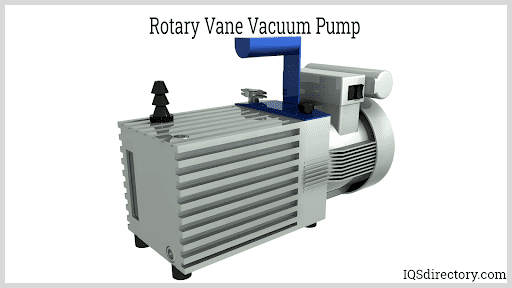
Rotary vane vacuum pumps are vacuum pumps that generate low-pressure zones by rotating the moving parts against the pump casing. The mating surfaces of the rotor and the housing have very...
Please fill out the following form to submit a Request for Quote to any of the following companies listed on
This article gives industry insights into vacuum systems and vacuum pumps. Read further to learn more.
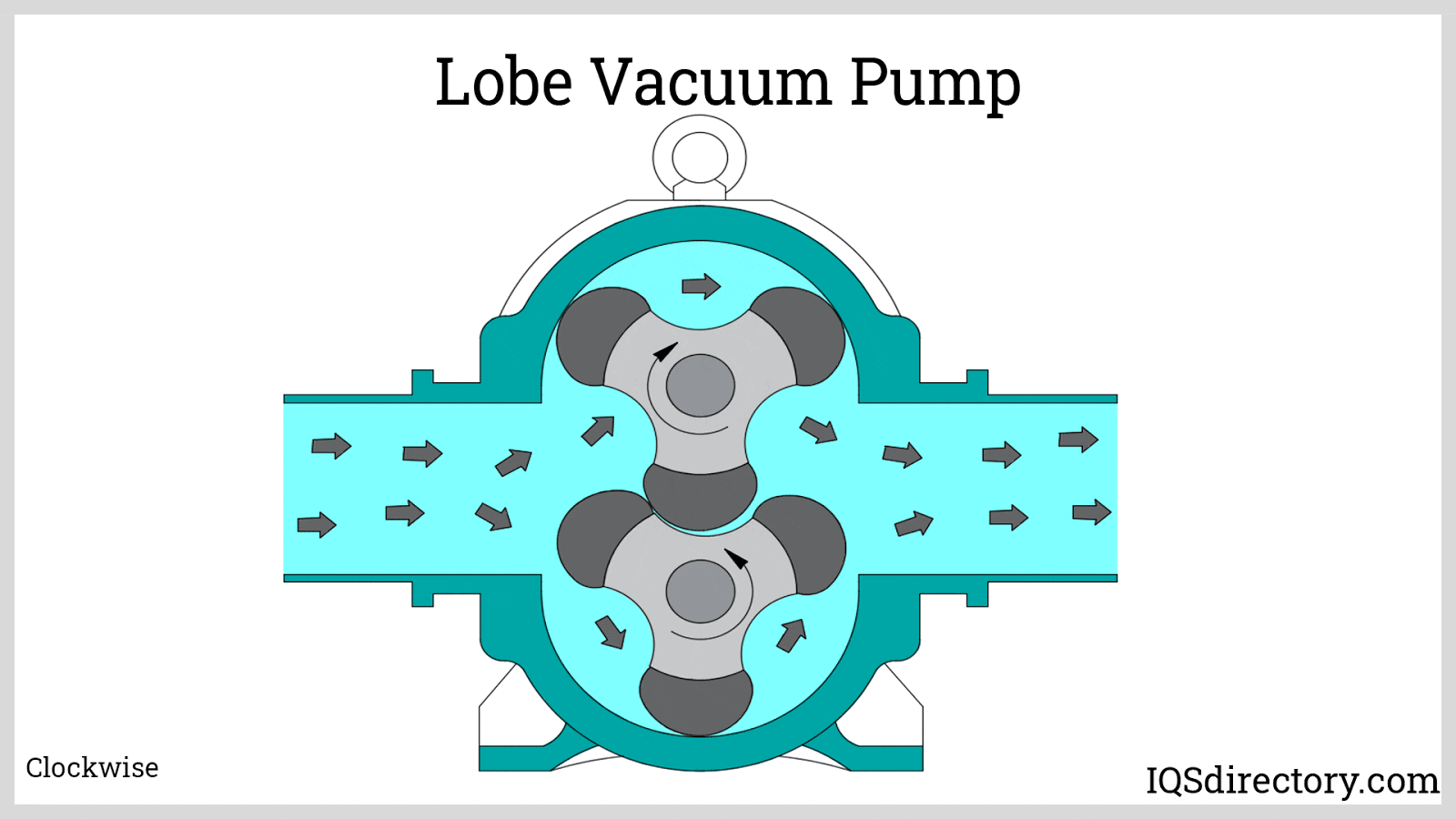
A vacuum pump is a device engineered to produce a partial or low-pressure vacuum by extracting gas or air molecules from a sealed environment. The word "vacuum" indicates a pressure condition where the chamber's pressure is lower than the atmospheric pressure or neighboring systems. This situation is distinct from an absolute vacuum, which describes a state with a pressure of 0 Pa (Pascal), completely free of gas particles.
Atmospheric pressure, the force exerted by air on the Earth's surface, is a central element in vacuum pump functionality. This pressure results from air molecules' weight and diminishes as one ascends to higher altitudes. Atmospheric pressure has a profound effect on machinery operations, including vacuum pumps. It seeks equilibrium by moving molecules from high-pressure areas to zones of lower pressure, in line with the tendency to fill vacuum or low-pressure gaps.
The primary goal of pumps is to transform energy into pressure. The energy needed for a pump's function is dependent on atmospheric pressure. Generally, increased atmospheric pressure enhances vacuum pump efficiency. Since atmospheric pressure greatly influences vacuum pump performance, it directly impacts operating expenses and can vary with temperature, humidity, and elevation changes.
Diverse levels of vacuum are attainable, from low vacuums with absolute pressures of 1 to 0.03 bars to high vacuums that achieve pressures as minimal as a billionth of a Pascal. Low and medium vacuums are commonly employed in industrial settings such as vacuum grippers, vacuum cleaners, incandescent bulbs, painting, sandblasting, vacuum furnaces, and negative pressure ventilation. Conversely, higher vacuum systems are vital for specialized laboratory activities like particle accelerators and reactors.
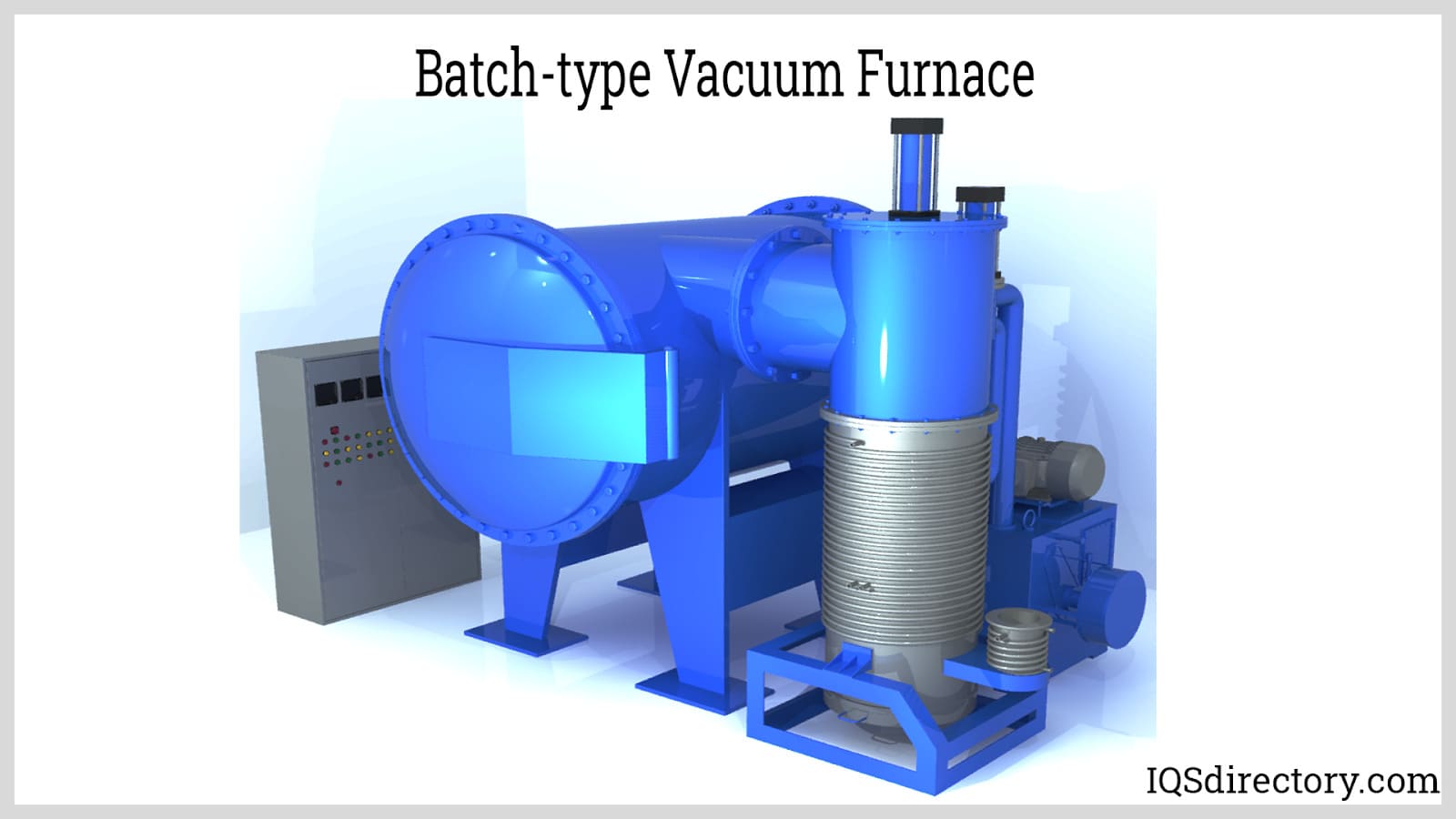
Two main techniques for creating a partial vacuum exist: gas transfer and entrapment. Gas transfer approaches include positive displacement vacuum pumps, which employ chambers that cyclically expand and contract using check or non-return valves to intake and expel gases, and momentum transfer vacuum pumps, which accelerate gases, forming a low-pressure trail. Conversely, entrapment vacuum pumps trap gas molecules through various processes such as condensation, converting gases into liquid or solid states; sublimation, where gases shift directly to a solid; adsorption, involving adherence of gas molecules to surfaces; and ionization, wherein gases are ionized before capture. Each technique has particular benefits depending on the vacuum system's needs.
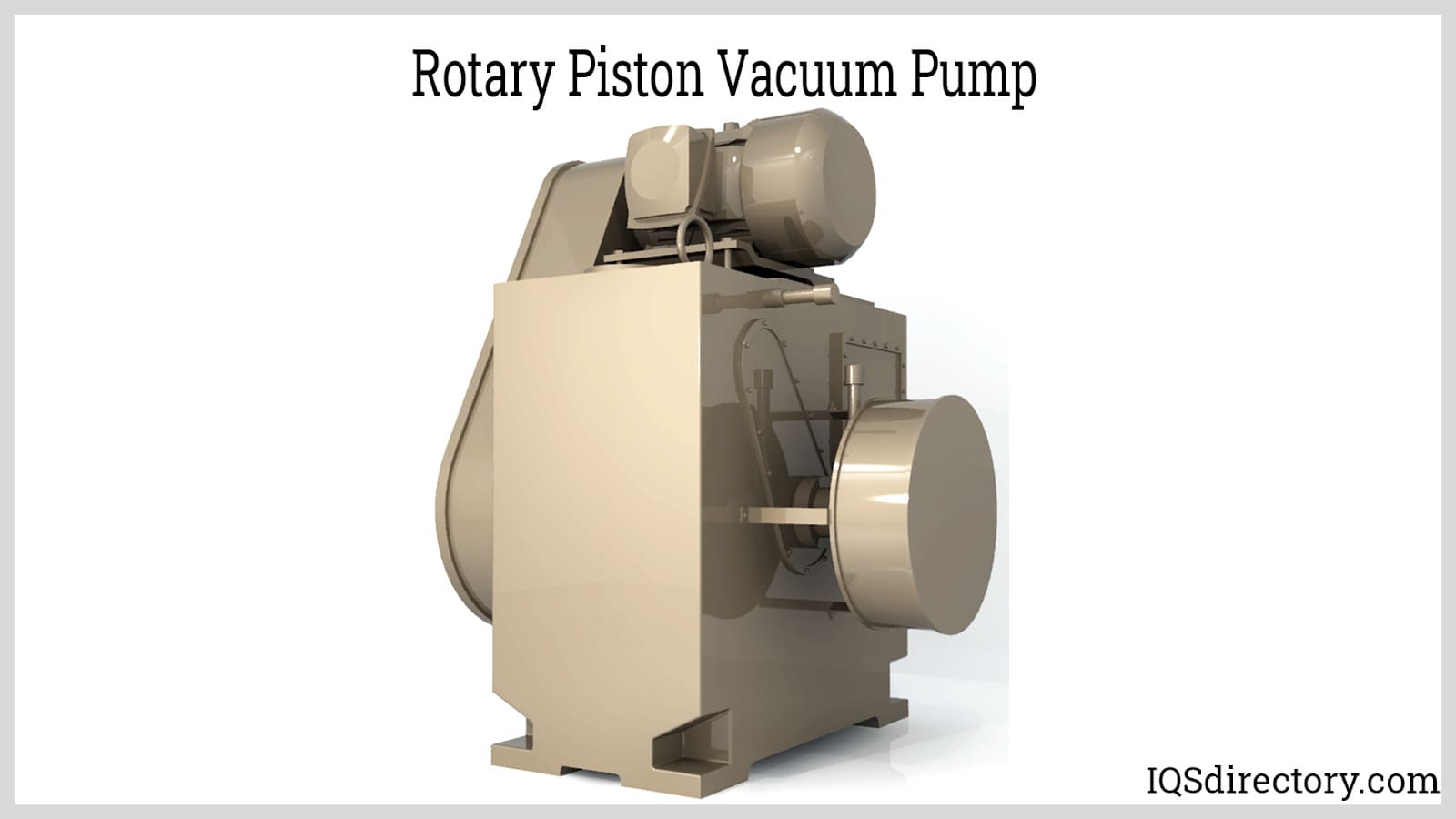
Vacuum ranges are defined by the measurement of the absolute pressure within the system, which reflects the number of remaining gas molecules. These residual molecules are typically nitrogen, oxygen, and water vapor, with trace amounts of neon, helium, and hydrogen. As the vacuum system removes more molecules, it becomes increasingly challenging to evacuate additional ones. The fewer the molecules remaining, the harder the vacuum system must work, and the more energy it consumes, as it strives to lower the pressure further. This is due to the diminishing number of molecules to be removed, making it increasingly difficult to achieve and maintain a lower pressure reading.
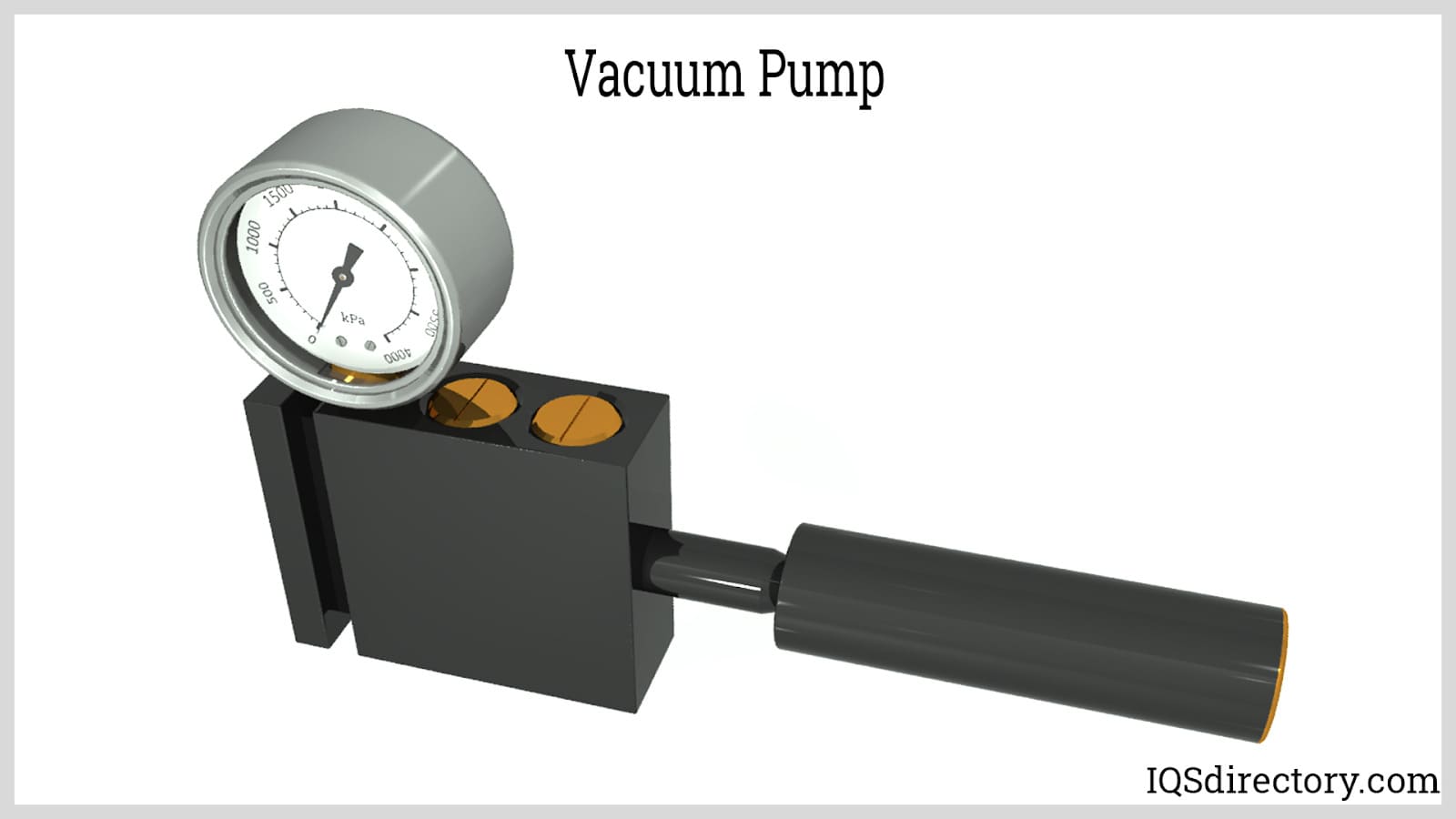
Different vacuum ranges necessitate distinct pumping techniques. Low and medium vacuum ranges are typically achieved using positive displacement vacuum pumps, which are suitable for most industrial applications. For high and ultra-high vacuum ranges, required for specialized applications such as surface analysis, microscopy, and nanolithography, both momentum transfer and entrapment pumps are employed. Momentum transfer pumps work by accelerating gases to create a low-pressure region, while entrapment pumps capture gas molecules through various mechanisms, such as condensation and adsorption, to achieve the desired vacuum levels.
| Vacuum Range | Absolute Pressure (Pa) |
|---|---|
| Atmospheric | 101,325 |
| Low Vacuum (Rough, Coarse) | 1.01 x 10⁵ to 3.33 x 10³ |
| Medium Vacuum | 3.33 x 10³ to 1 x 10⁻¹ |
| High Vacuum | 1 x 10⁻¹ to 1x10⁻⁷ |
| Ultra-high Vacuum | 1 x 10⁻⁷ to 1 x 10⁻¹⁰ |
The two main classifications of vacuum pumping principles are gas transfer and entrapment. Gas transfer is further divided into positive displacement and momentum transfer. To fully understand vacuum pumps, it's essential to grasp the three types of flow: viscous, transitional, and molecular. Viscous or continuous flow occurs at high pressures and medium vacuum levels, where gas molecules are dense enough to collide with each other. The mean free path, or the average distance a gas molecule travels before colliding with another molecule, is shorter than the chamber's dimensions. As the vacuum level increases, gas molecules begin to collide with the chamber walls more frequently than with each other. Transitional flow represents the intermediate stage where viscous flow starts transitioning into molecular flow. Molecular flow is characterized by the random movement of gas molecules, where their mean free path is significantly longer than the dimensions of the chamber.
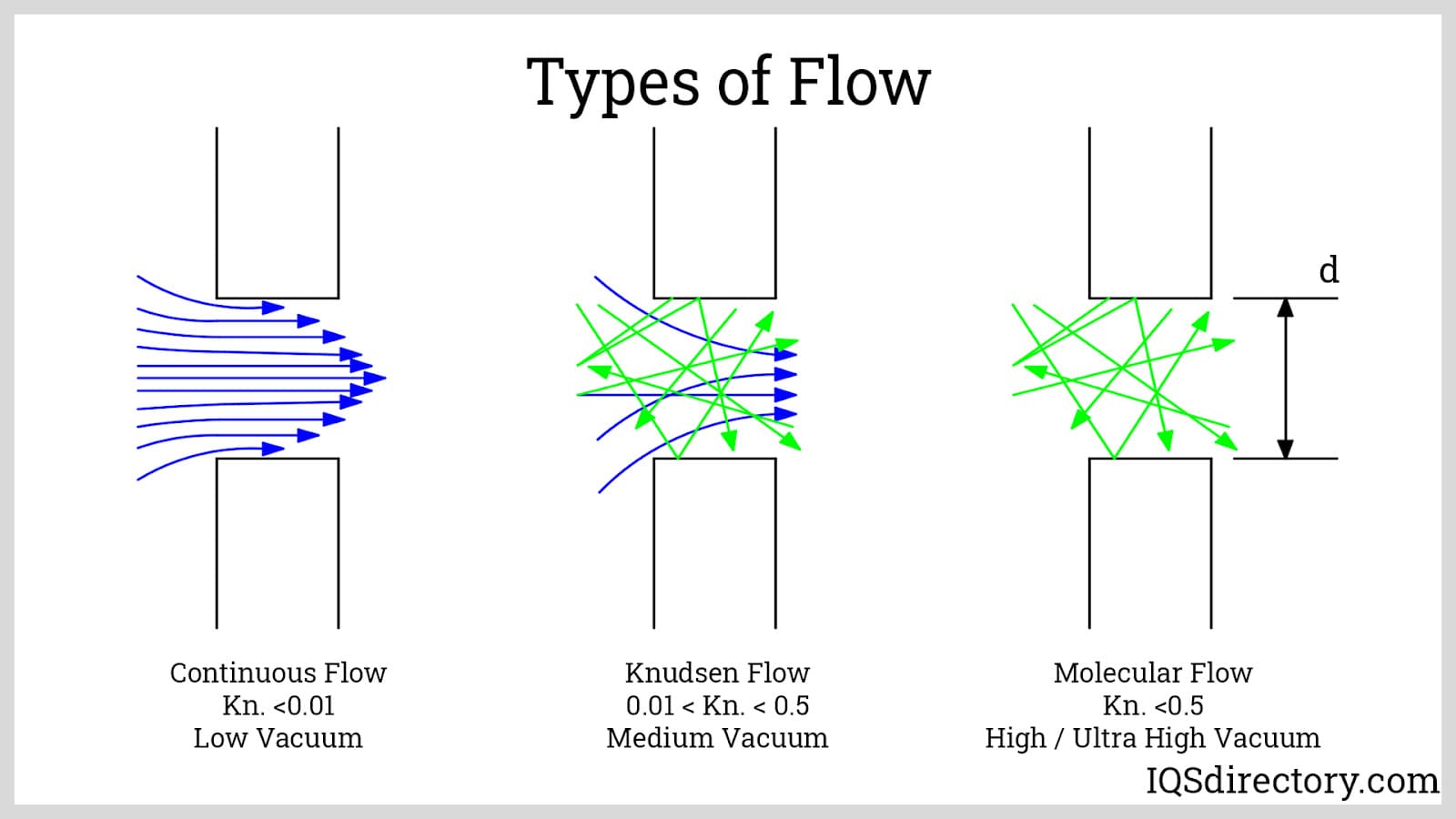
Fluids flowing under viscous flow can be effectively pumped mechanically by positive displacement pumps. However, as the vacuum level increases and the gas moves into molecular flow, positive displacement pumps alone become insufficient. At this stage, a different pumping system either momentum transfer or entrapment is required. Most high vacuum systems utilize a combination of pumps operating in tandem. Positive displacement pumps are not effective at higher vacuum levels, while momentum transfer pumps can stall if operated in a viscous flow regime. Entrapment pumps, on the other hand, may need to be frequently regenerated or exhausted when dealing with substantial gas quantities, especially in viscous flow conditions.
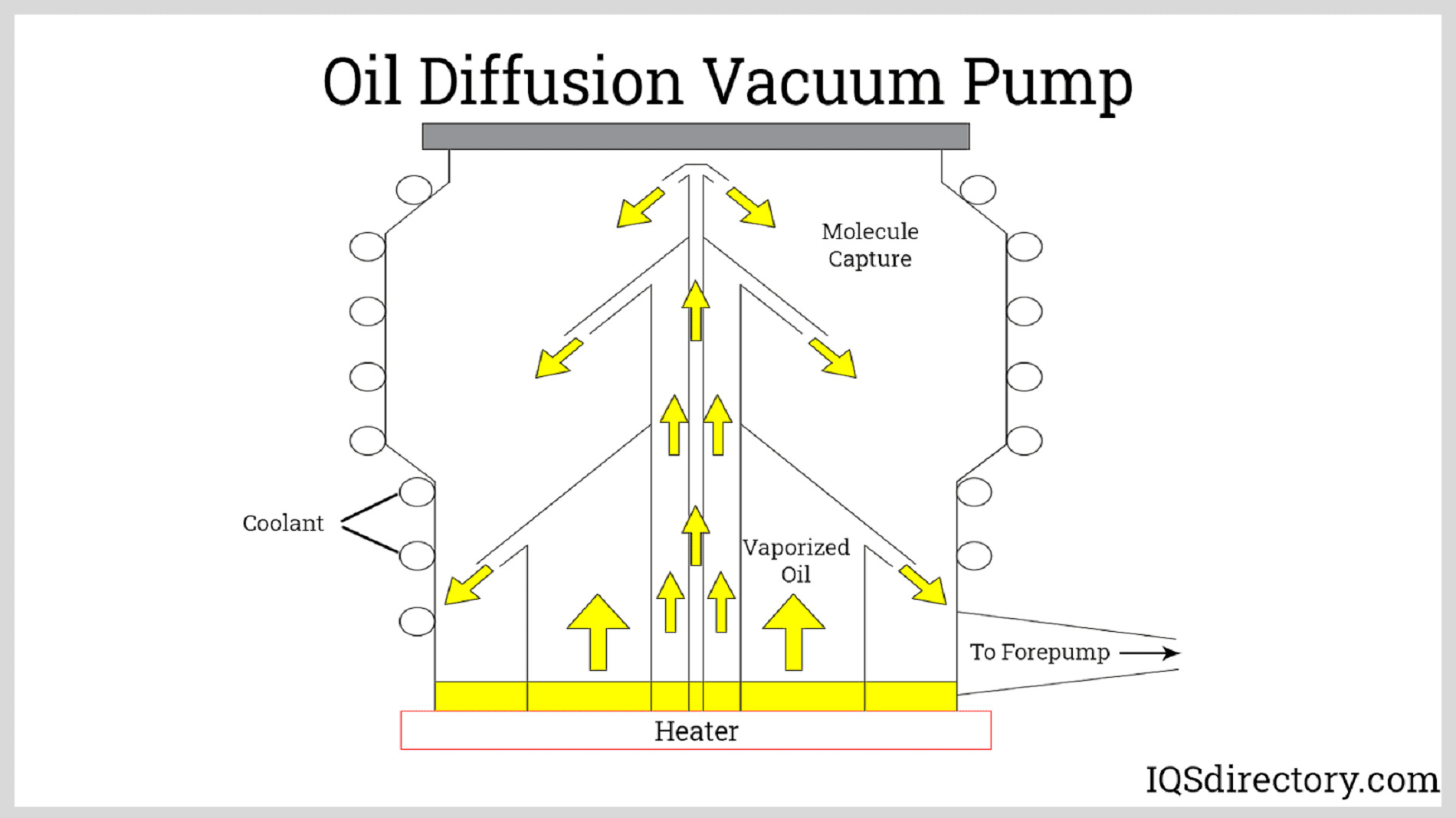
Positive displacement vacuum pumps work by repeatedly expanding and contracting a sealed chamber, with the flow of fluid regulated by one-way valves. The process begins with the expansion of the chamber, creating a vacuum that draws fluid in through an intake valve. Once the chamber reaches its maximum expansion, the intake valve closes and the exhaust valve opens. As the chamber compresses, the fluid is expelled through the exhaust. This cycle of expansion and contraction occurs several times per second, generating a pulsating flow.
Similar to ordinary pumps, positive displacement vacuum pumps are categorized based on the motion and design of their chambers. The two primary types are reciprocating and rotary pumps.
Reciprocating Piston Vacuum Pump: This pump creates vacuum and compression through the movement of a piston within a sealed cylinder. The piston, attached to the crankshaft via a connecting rod, moves back and forth as the crankshaft rotates. Reciprocating piston pumps typically use pistons made of cast iron, bronze, or steel.
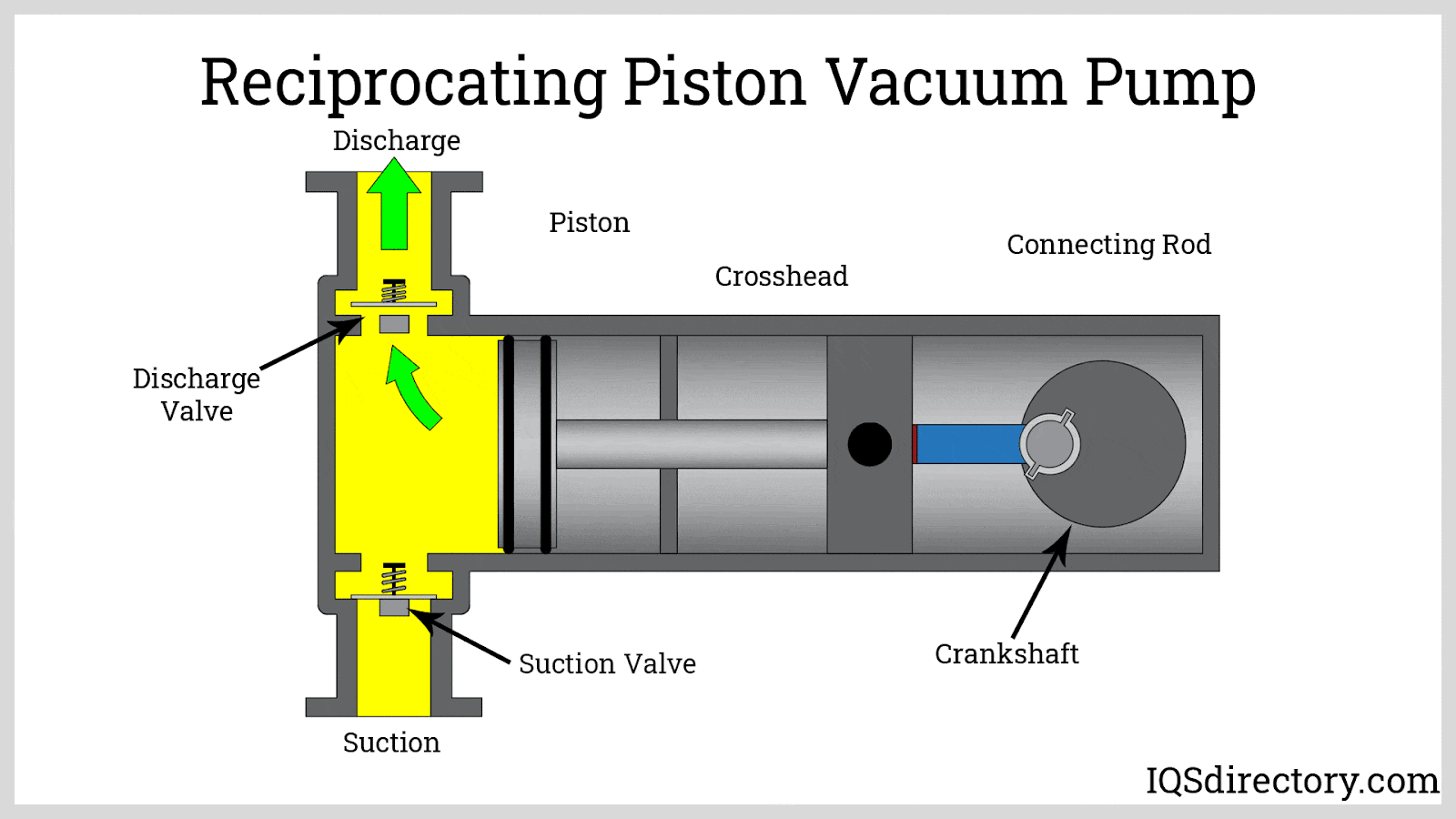
Plunger Vacuum Pump: Operating similarly to a reciprocating piston pump, the plunger vacuum pump features a long, solid cylinder, usually made of hard-coated ceramic. Unlike piston pumps, where the seal is attached to the moving piston, the plunger's extended profile allows the high-pressure seal to remain stationary relative to the cylinder. This design accommodates more complex sealing systems and makes plunger vacuum pumps better suited for more demanding conditions.
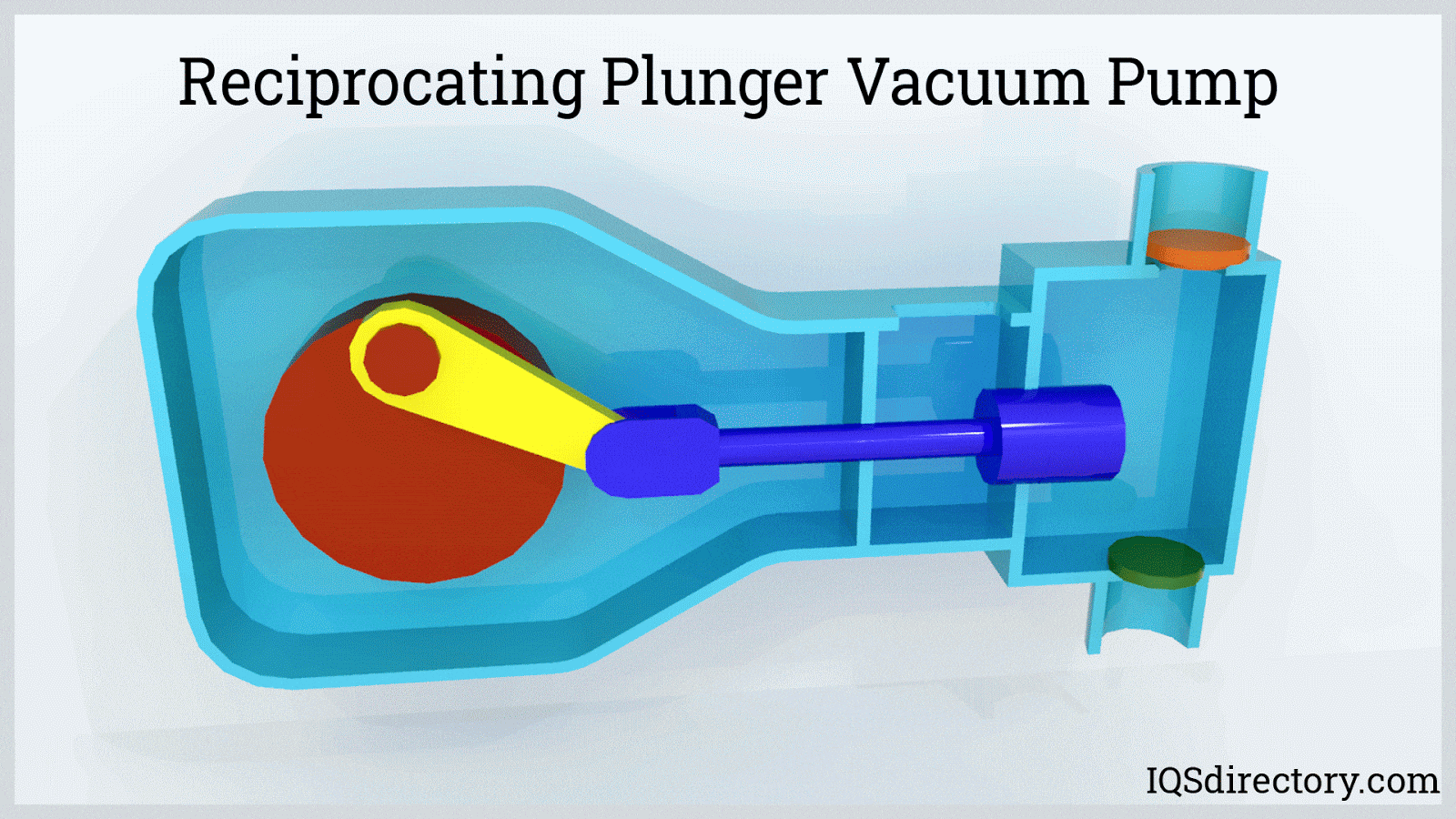
Diaphragm Vacuum Pump: Diaphragm vacuum pumps utilize a flexible metallic or elastomer membrane that forms a hermetic seal within the chamber. While piston vacuum pumps are generally preferred for their reliability and power, diaphragm vacuum pumps are ideal for handling hazardous or corrosive substances due to their robust sealing capabilities.
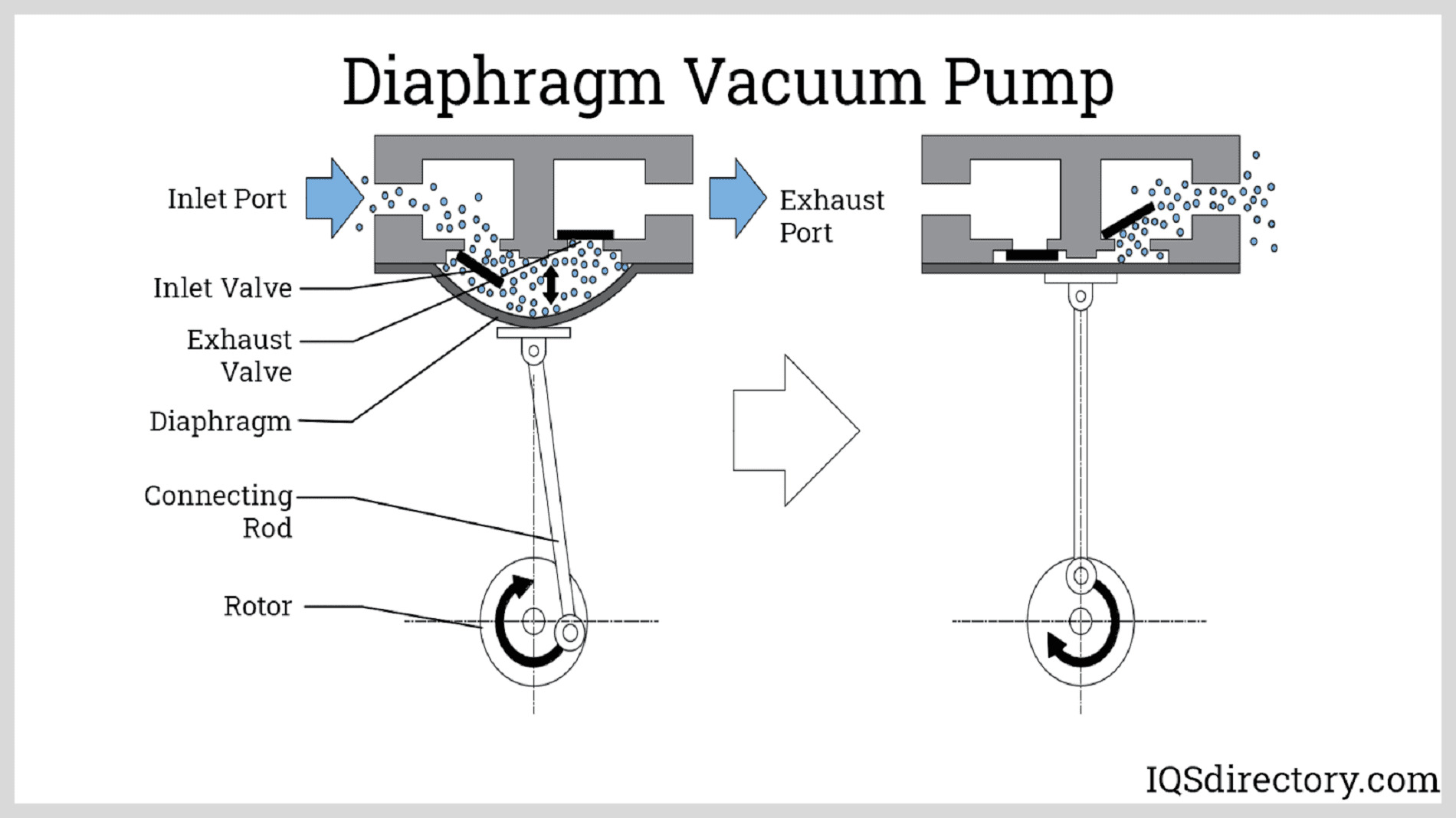
Reciprocating vacuum pumps can also be classified based on the number of chambers to mitigate the issue of pulsating flow, which is characterized by intermittent bursts rather than a steady stream. To achieve a more consistent flow, pumps with multiple pistons and cylinders are used. This led to the development of multiplex pumps, which feature several piston-cylinder assemblies to reduce pulsation and deliver a smoother flow.
Reciprocating pumps are classified based on their cycle phase per stroke as either single- or double-acting. Single-acting pumps generate either vacuum or compression with each stroke. In this design, the piston or diaphragm is linked to a single chamber, with only one side interacting with the fluid. A Double-acting pumps, on the other hand, produce both vacuum and compression during each stroke. This is often achieved with a twin piston-cylinder or twin diaphragm assembly actuated by a single drive rod, though some designs use a single piston or diaphragm serving two chambers. Double-acting pumps are preferred for their greater efficiency, higher flow rates, and reduced pulsation.
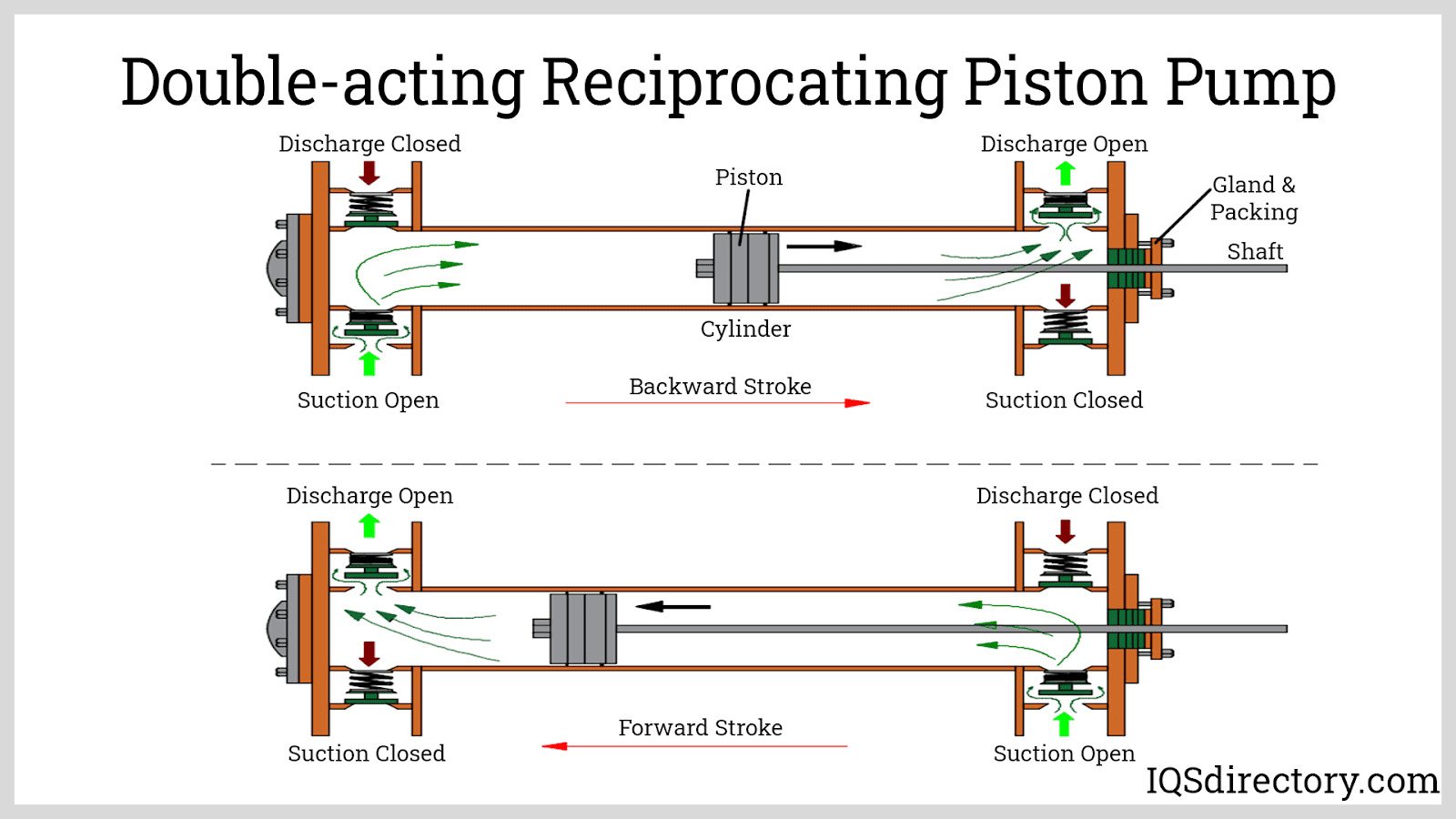
Rotary Vane Vacuum Pump: Rotary vane vacuum pumps are one of the most common types of positive displacement vacuum pumps. They feature vanes that are inserted radially into a circular rotor, which is installed eccentrically within the stator housing. This eccentric placement, known as the stroke of the pump, causes the chambers separated by the vanes to progressively decrease in size as they approach the discharge. The vanes are designed to move radially and press against the housing primarily due to centrifugal force generated by the rotating rotor. A spring either energizes the vanes or holds them in place when the rotor is stationary.
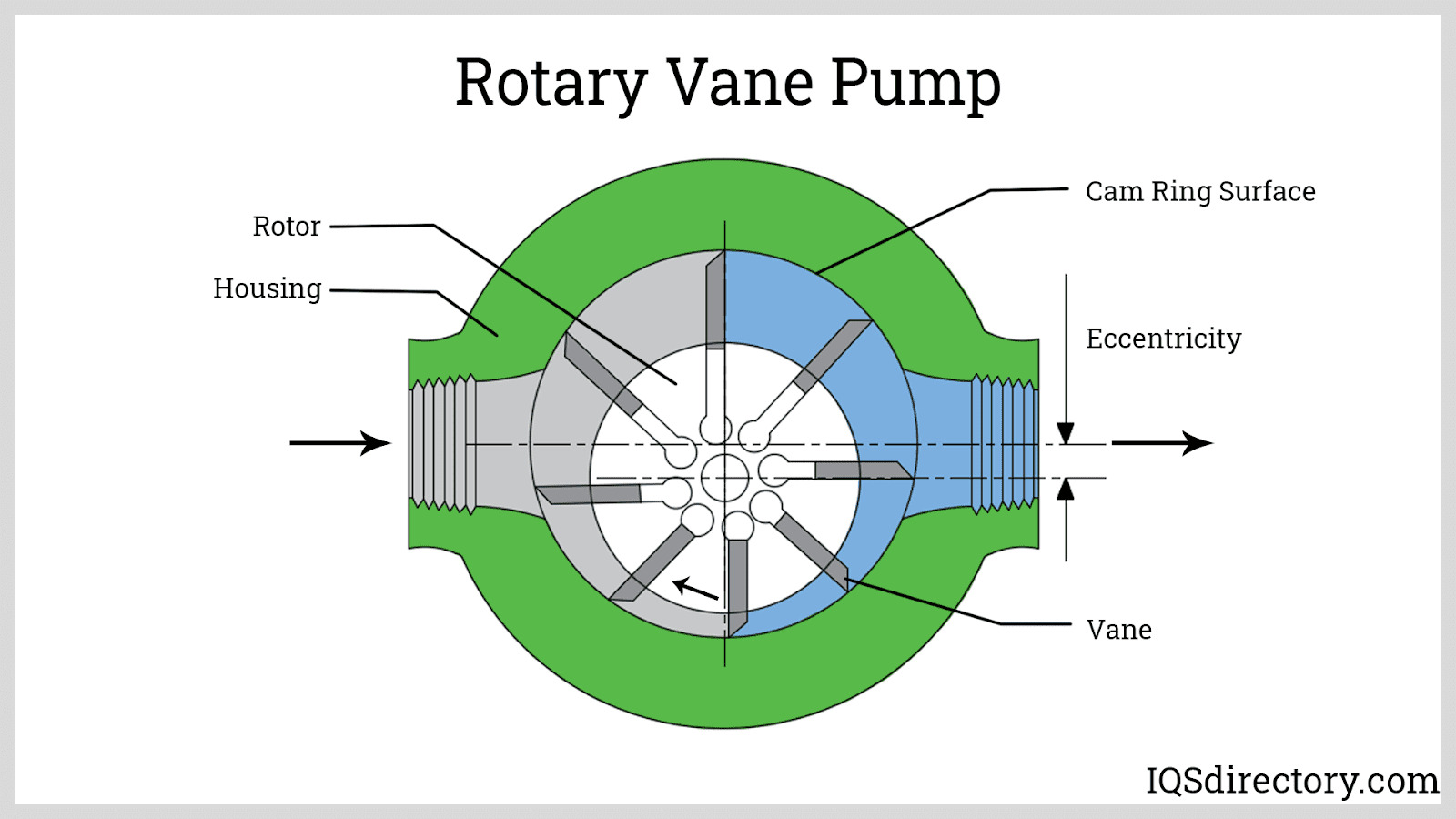
Rotary Piston Vacuum Pump: A rotary piston vacuum pump features an eccentric wheel as the rotor, which is connected to a slide valve. These pumps can be viewed as two-stroke, double-acting systems with two distinct compression chambers. During the intake stroke of the first chamber, the slide valve opens to allow fluid entry. Simultaneously, the opposite chamber undergoes an exhaust stroke, where an exhaust valve expels the compressed fluid. Similar to rotary vane pumps, the compression chamber is formed by the interaction between the rotor, in this case, the eccentric wheel, and the pump housing. This chamber progressively reduces in size towards the end of the exhaust stroke.
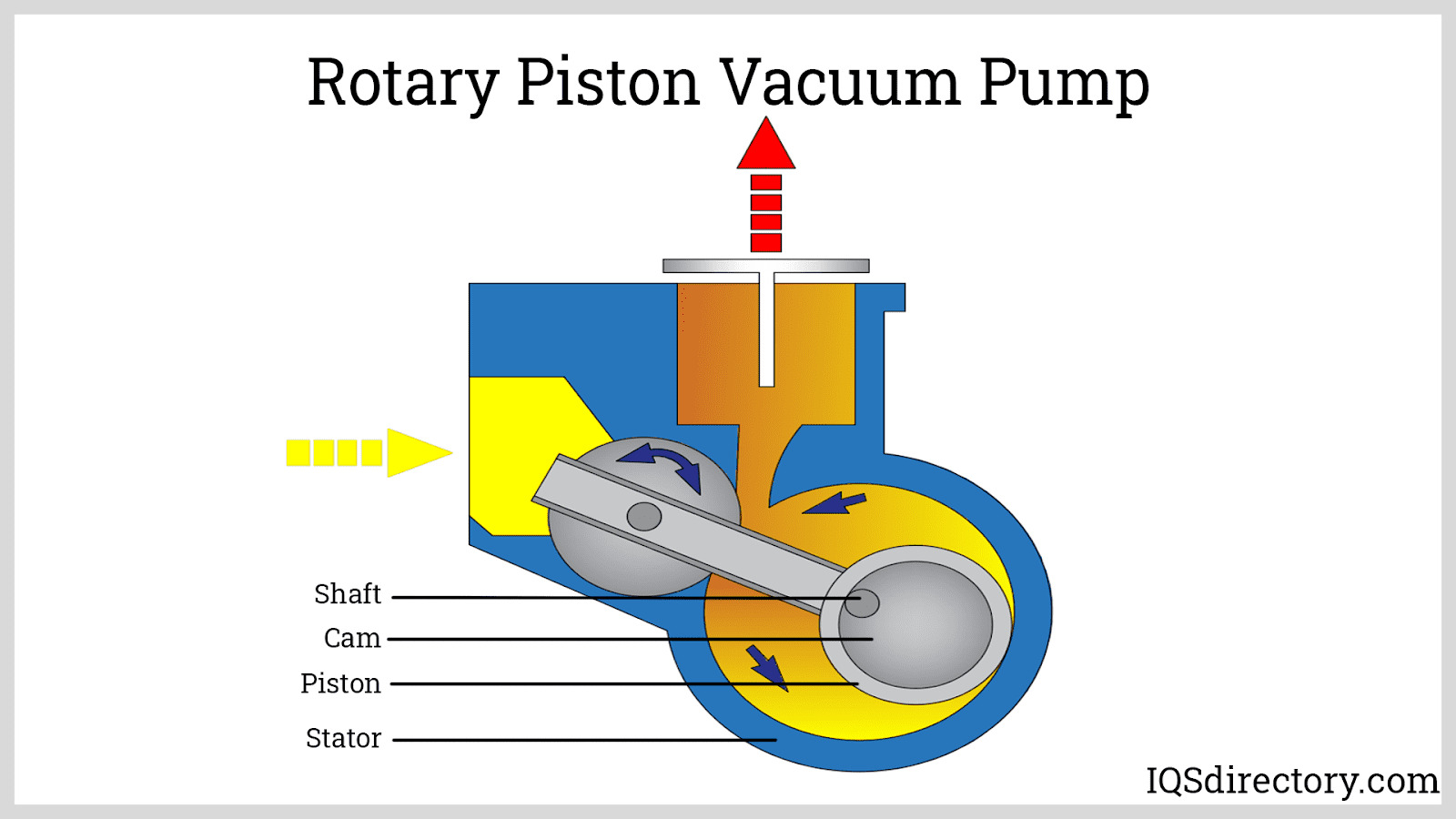
Screw Vacuum Pump: The rotary screw pump, originally known as Archimedes' screw, is one of the earliest positive displacement pumps. In its basic form, it consists of a single screw enclosed within a hollow cylinder. Modern versions often feature double or triple screws that mesh with each other. As fluid enters the pump, it becomes trapped in the cavities formed between the screw threads and the housing. The rotation of the screw generates pressure, pushing the fluid to the discharge side. This pump is well-suited for handling both single and multiphase fluids and can tolerate fluids containing abrasive contaminants.
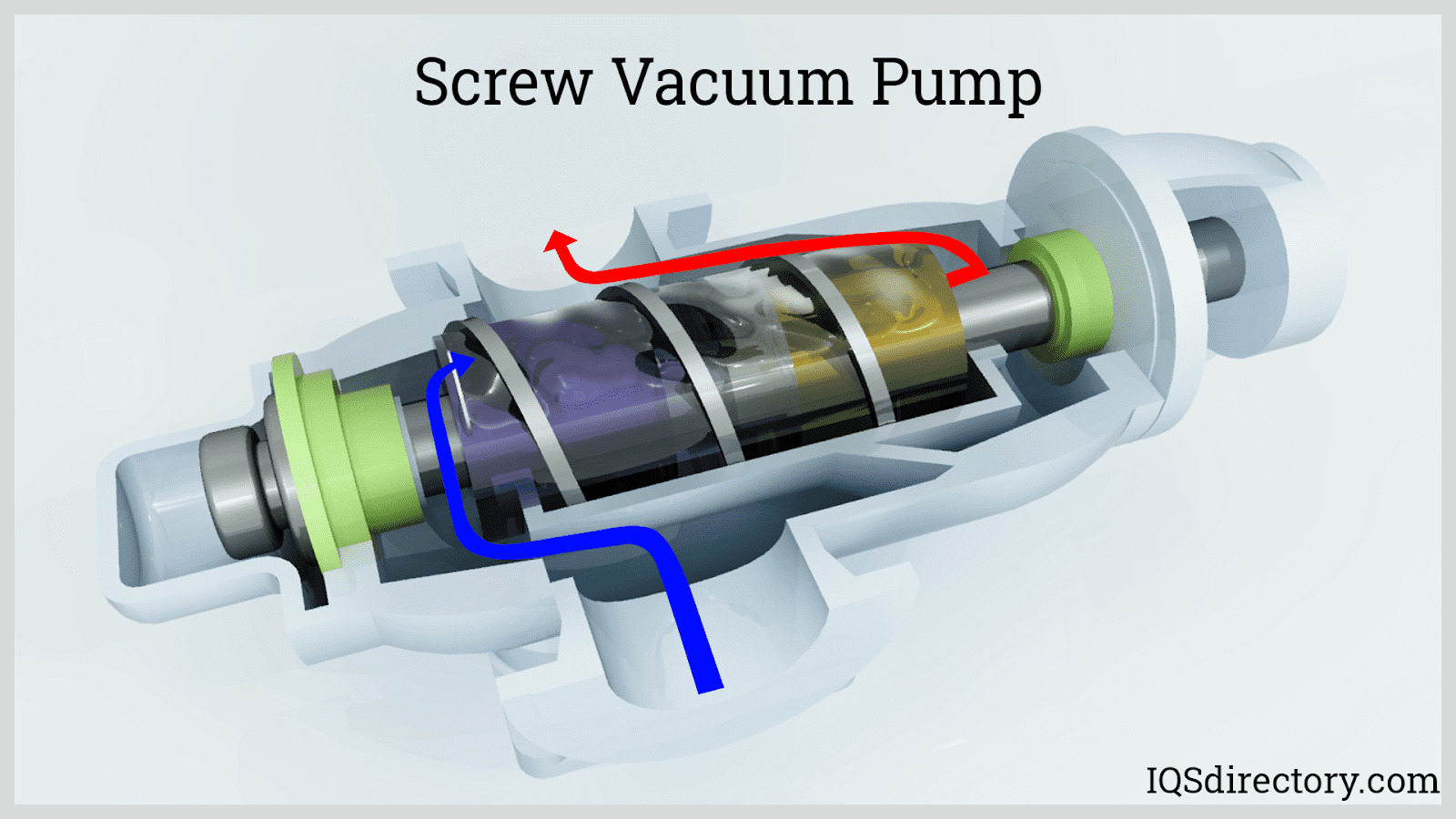
Gear Vacuum Pump: Gear vacuum pumps feature two interlocking gears, where one gear drives the other. They can be classified as either external or internal gear pumps. In an external gear pump, two external gears mesh with each other. As the gears rotate, they create an expanding cavity by moving out of mesh, generating a vacuum that draws fluid into this space. The fluid is then trapped between the gear teeth and the pump housing and is expelled on the opposite side as the gears continue to rotate. Internal gear pumps, on the other hand, consist of a driven external gear and an internal gear. These pumps operate similarly to external gear pumps, with fluid being drawn into the expanding cavity as the gear teeth disengage.
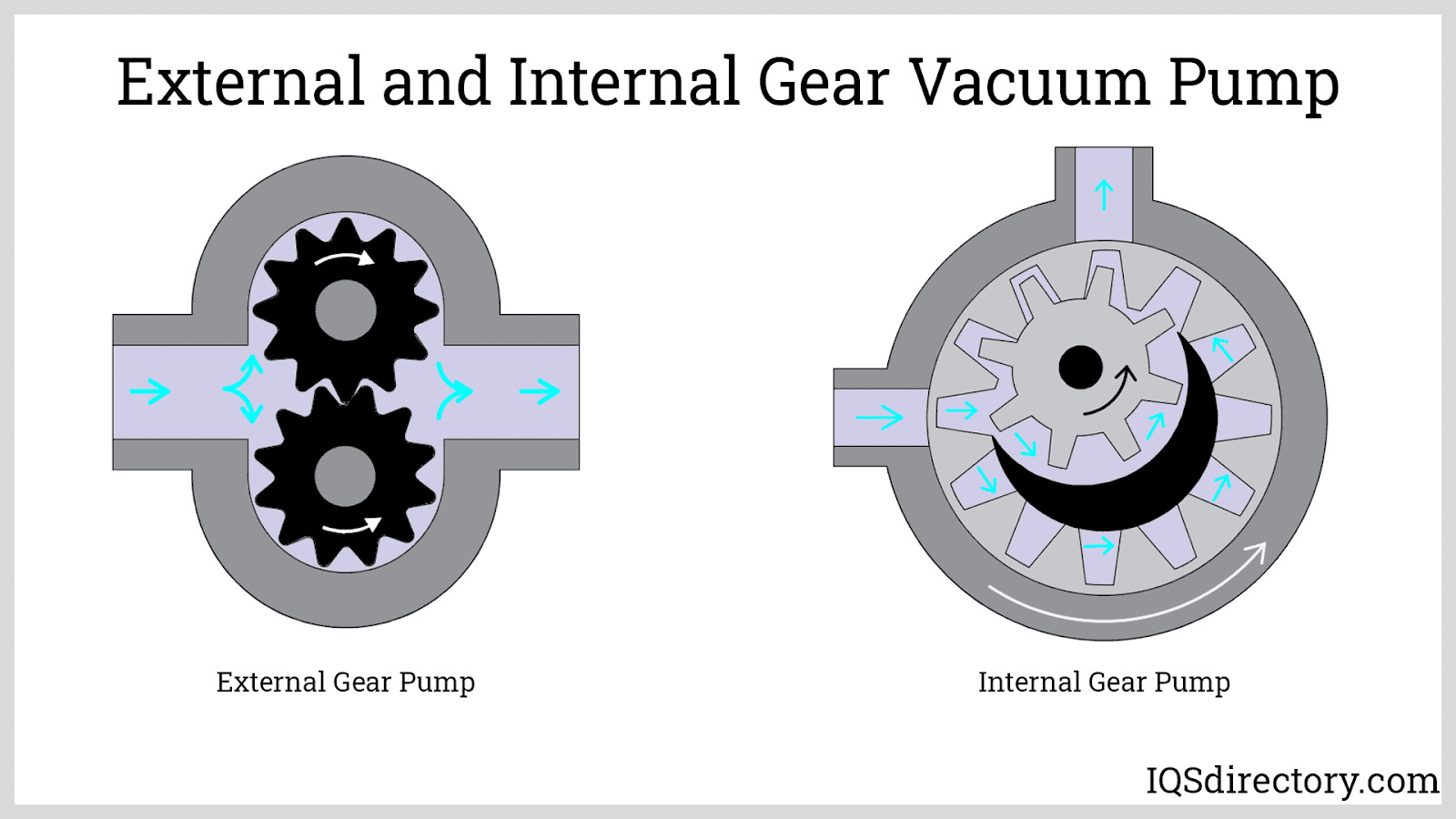
Scroll Vacuum Pump: A scroll vacuum pump consists of two coiled spirals or scrolls, with one serving as the rotor and the other as the stator. Instead of rotating, the rotor moves eccentrically relative to the stator. The pump operates by drawing fluid in from the outer edges of the scrolls. As the fluid is trapped between the scrolls, it is moved toward the center, where the volume is progressively reduced.
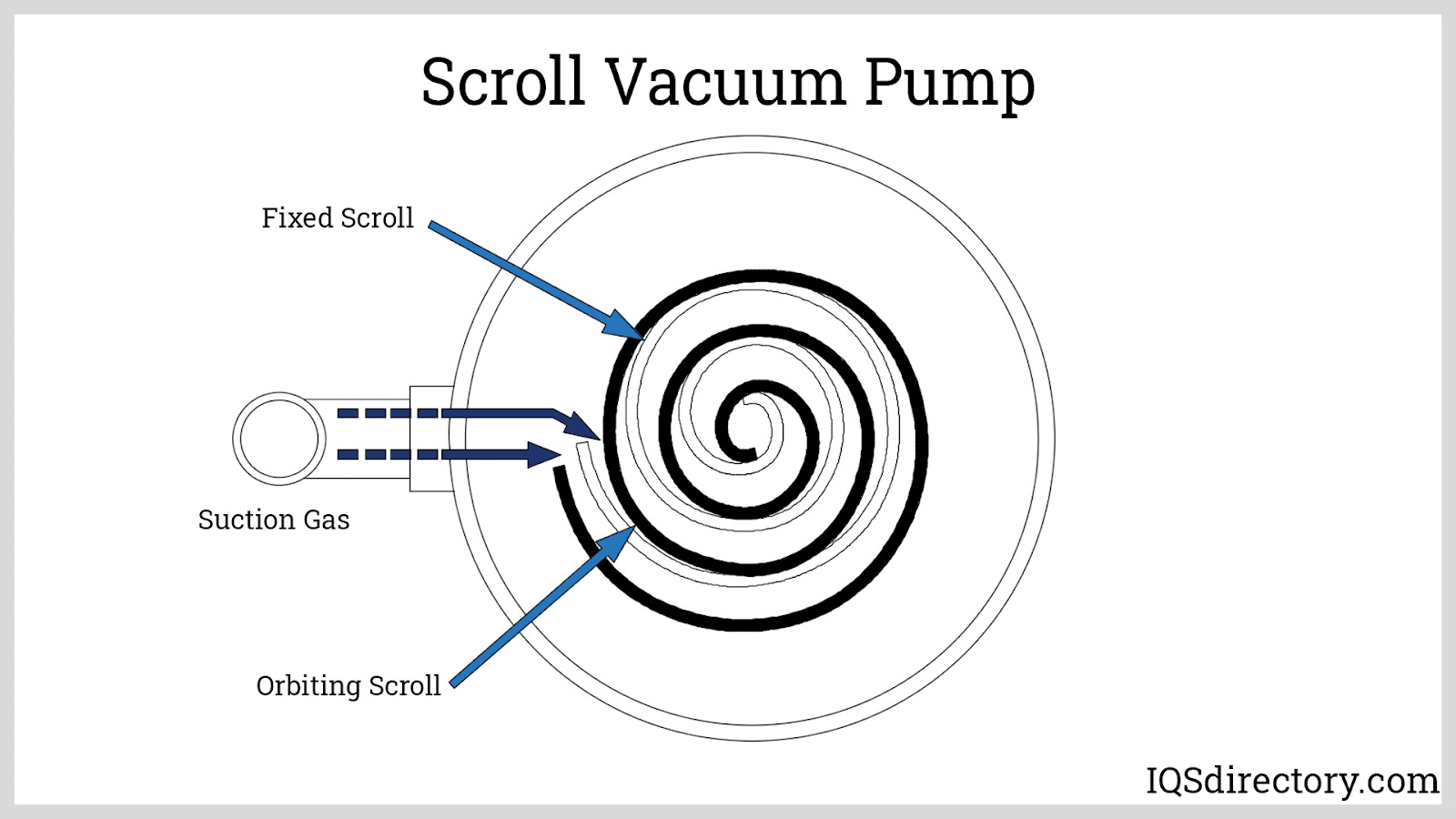
Momentum transfer pumps function by transferring kinetic energy to gas or liquid molecules, inducing their movement. Unlike positive displacement pumps, which operate through viscous or continuous flow, momentum transfer pumps work at the molecular flow level. In these pumps, fast-moving surfaces such as those on an impeller continuously alter the uniform velocity distribution of the molecules, directing them in a preferred direction. For instance, a diffusion pump uses high-speed jets of motive fluid to transfer momentum to gases, effectively drawing them from the inlet. Momentum transfer pumps are ideal for achieving high vacuum levels. However, for molecular flow to be established, low pressure must be maintained throughout the system. Directly releasing the exhaust to the atmosphere or at pressures where backstreaming might occur is problematic. To address this, a backing pump, often a positive displacement pump, is used in conjunction with the vacuum pump. The backing pump operates at a lower vacuum level and can discharge directly to the atmosphere.
Turbomolecular Vacuum Pump: A turbomolecular vacuum pump features multiple stages of rotating and stationary turbine blades. The rotating blades are angled to transfer significant momentum to the gas molecules, propelling them axially through successive stages toward the exhaust. The stationary blades, also angled, guide the gas in the correct direction. Due to the small mass of the gas molecules, the rotors must spin at extremely high speeds. However, design considerations for turbomolecular pumps are constrained by factors such as friction heat buildup and rotor deflection.
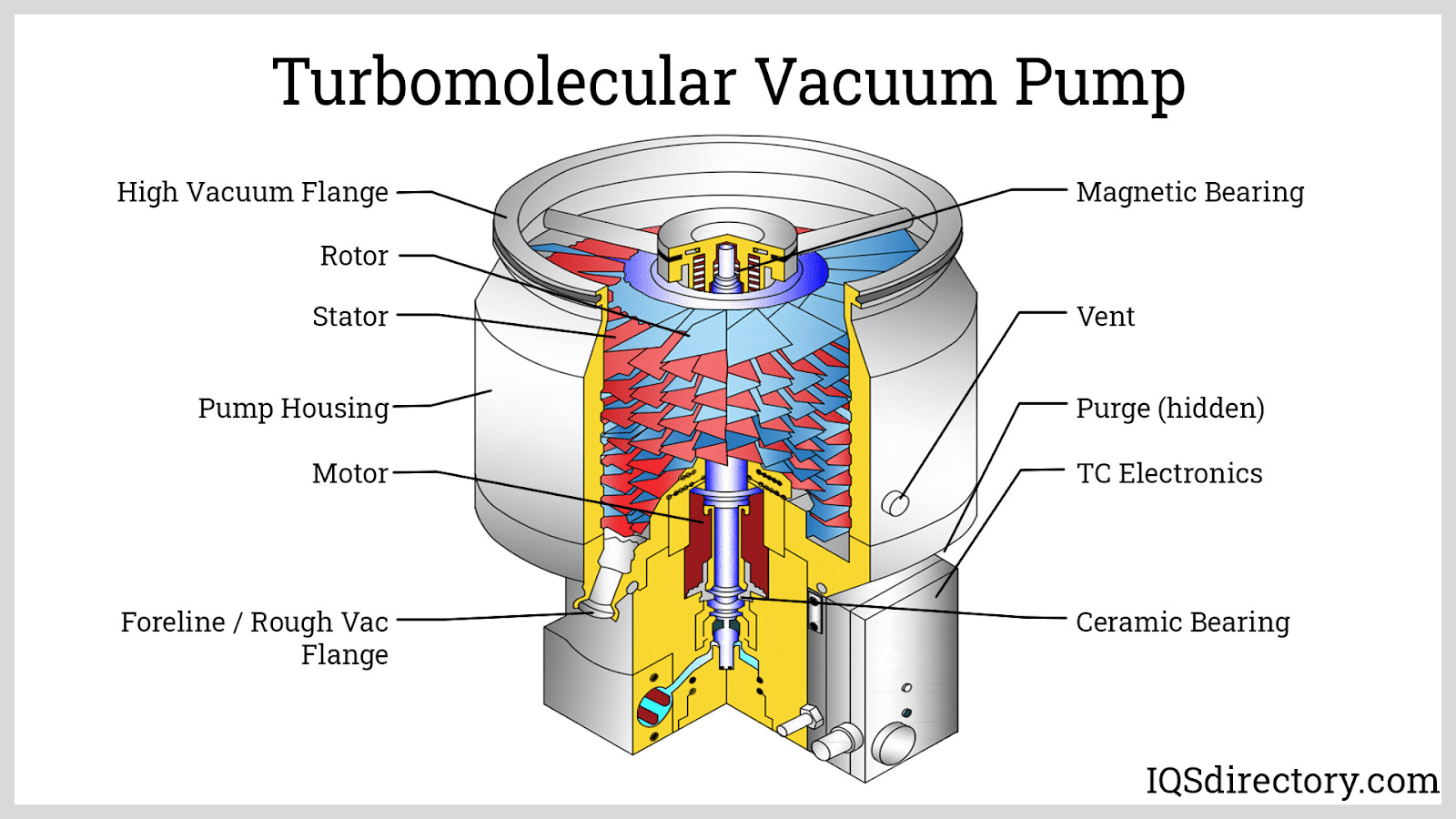
Diffusion Vacuum Pump: A diffusion pump operates by using a motive fluid, such as oil or steam, to transfer momentum to gas molecules. In an oil diffusion pump, the design includes a heater to vaporize the oil, which is then expelled through nozzles at the top of the boiler or vaporizing chamber at supersonic speeds. This high-speed oil vapor interacts with and captures the randomly flowing gases from the low-pressure chamber. Cooling coils are used to condense the vaporized oil, which then returns to the boiler for reuse. The captured gas molecules are directed towards the exhaust. Steam or hydrocarbon gas ejectors operate on a similar principle but do not require a boiler, as the steam or motive fluid is already in vapor form and has sufficient velocity.
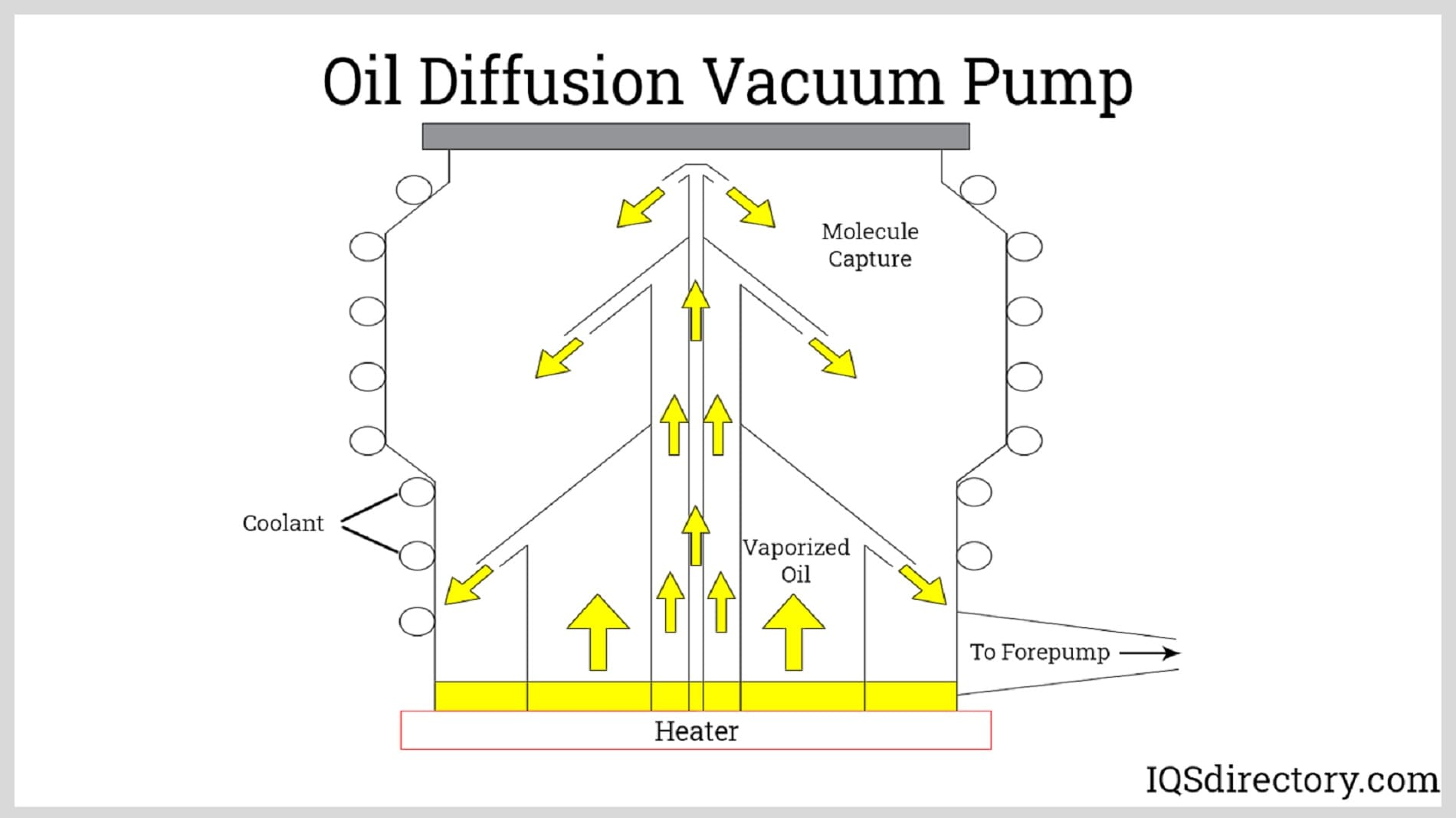
Entrapment vacuum pumps utilize various physical and chemical processes to capture gas molecules. While each type operates on different principles, they share a common advantage: the ability to achieve high vacuum levels without oil contamination. Unlike other pumps, entrapment vacuum pumps do not rely on rotors or moving parts. However, they have limitations, such as the need for regeneration once the capturing surface or material is saturated. Additionally, they are ineffective at removing lighter gases like hydrogen, helium, and neon. Below are some common types of entrapment vacuum pumps.
Cryogenic Vacuum Pump: Cryogenic vacuum pumps operate by cooling gases down to their condensation or freezing points. These pumps are effective at capturing gases like nitrogen and oxygen when cooled to below 20 K. For lighter gases such as helium and hydrogen, temperatures of 8 to 10 K are required. A typical cryogenic pump features a two-stage cooling system: the first stage cools to around 70 to 80 K to remove water vapor and oil, while the second stage cools to approximately 10 to 20 K to capture gases that condense at these lower temperatures. Additionally, an adsorbent material, such as activated charcoal, is often used in the second stage to trap the cooled gases.
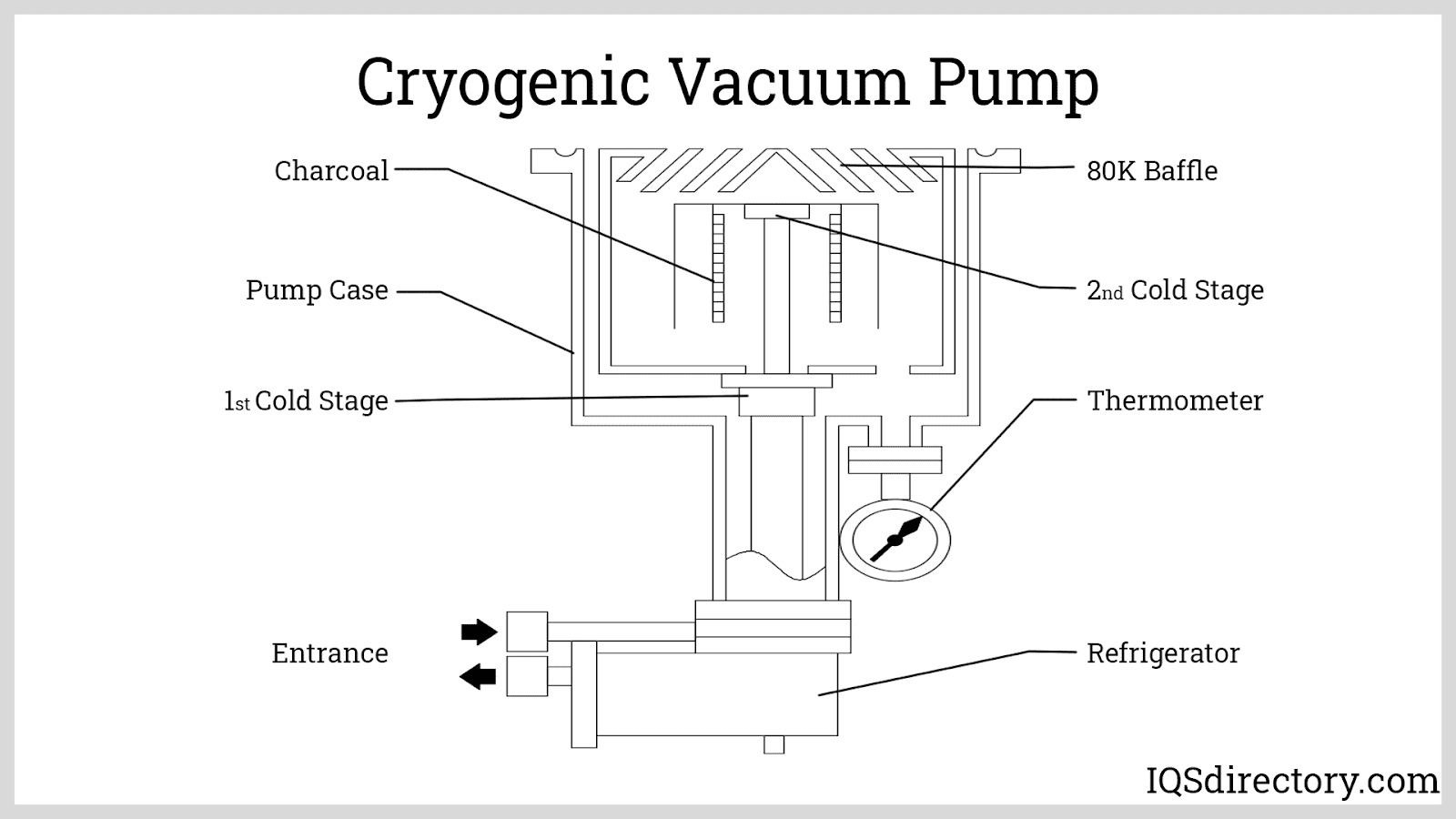
Sorption Vacuum Pump: Sorption vacuum pumps utilize adsorbents like activated charcoal, zeolite, or molecular sieves to capture gas molecules. These pumps are often used in conjunction with cryogenic pumps, which condense the gases or reduce their vapor pressure, enhancing the sorption process.
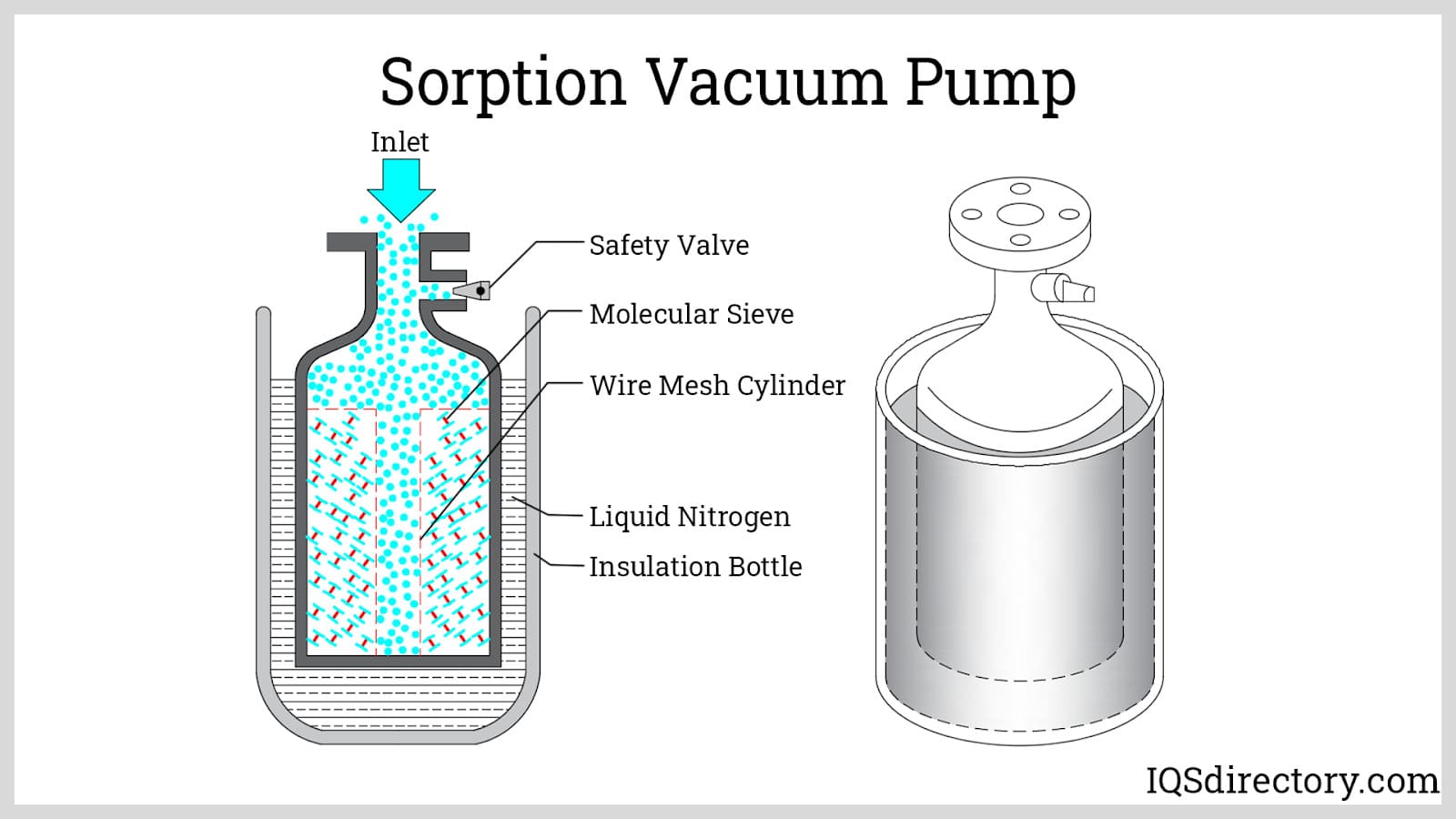
Sputter Ion Vacuum Pump: Also known as an ion getter pump or ion pump, a sputter ion vacuum pump operates by ionizing incoming gases using an anode. The ionized gases then interact with a cathode or getter, typically made of titanium. The binding of gases to the cathode can occur through chemical or physical means, depending on the type of gas. When the ionized gas strikes the cathode, it causes some atoms or electrons to be ejected from the surface in a process known as sputtering.
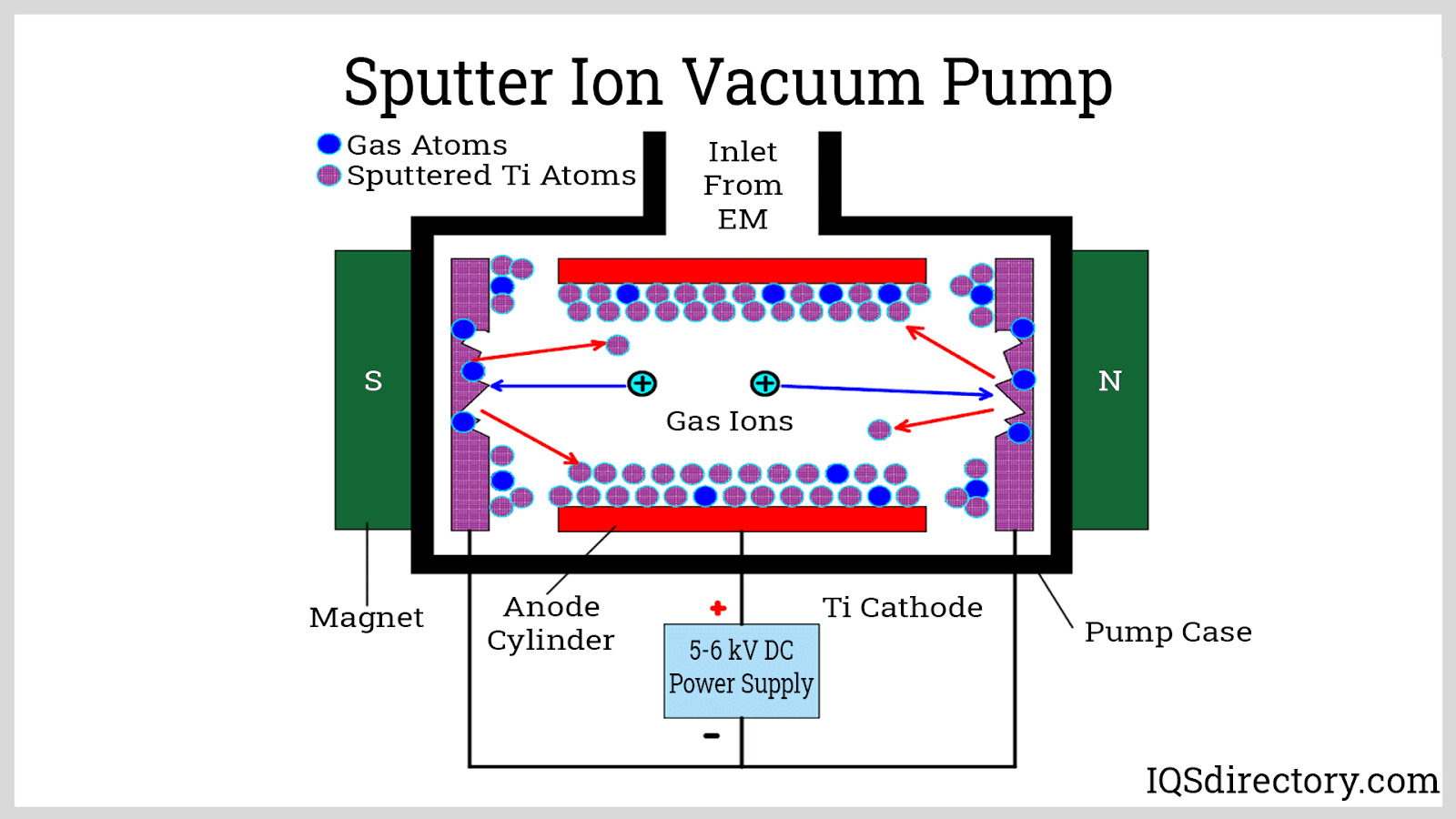
Titanium Sublimation Vacuum Pump: This type of vacuum pump works by passing an electric current through a titanium filament, which heats the titanium and causes it to vaporize inside the chamber. The vaporized titanium then captures gases present in the chamber by forming bonds with them, either while the gases are in transit or as the titanium forms a film on the chamber walls. Once the titanium film is used up, the filament is vaporized again to create a new layer of titanium for continued gas capture.
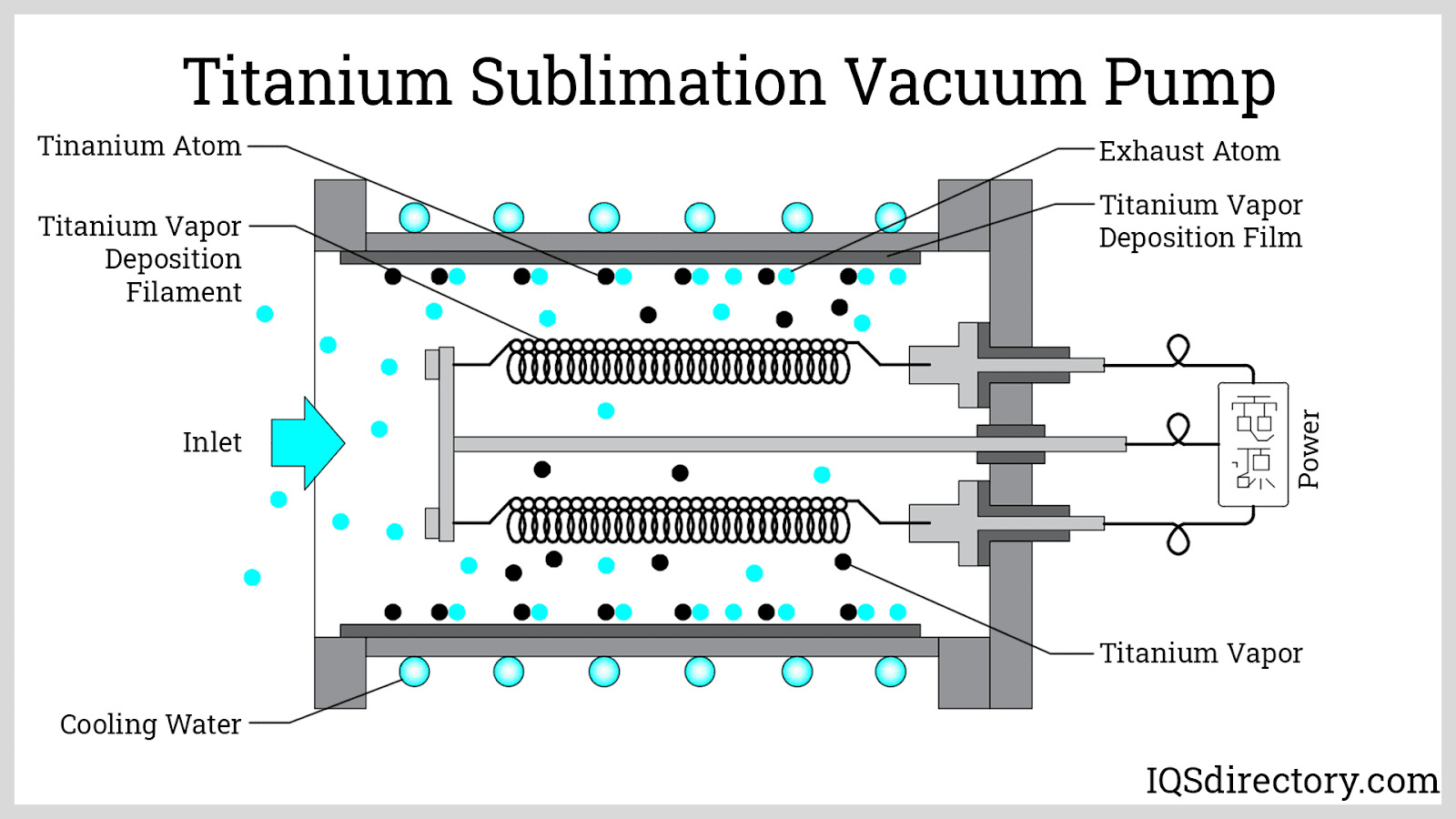
Centrifugal Pumps: Centrifugal pumps utilize velocity and momentum to move fluids, employing a fan and impellers to generate fluid velocity. Their operation is based on the principle of a forced vortex, where rotating a mass with an external force increases pressure. This rising pressure facilitates the transfer of fluid. Centrifugal pumps are ideal for handling large volumes of liquids with high flow rates, and they allow for easy adjustment of flow rates.
The key component of a centrifugal pump is its impeller, which accelerates the movement of the liquid. The impeller is mounted on a shaft that transmits torque through the shaft sleeve.
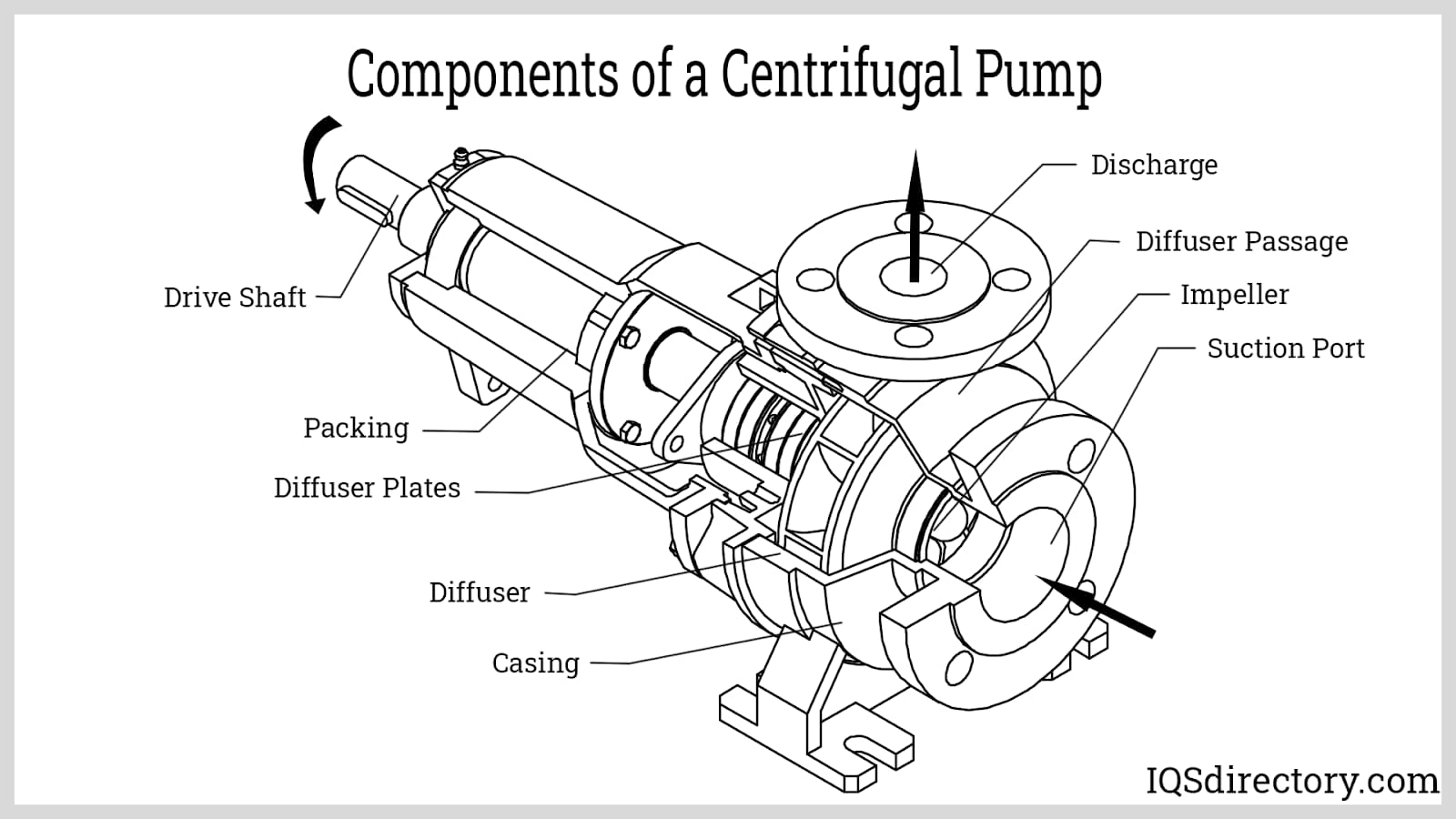
In addition to their operating principles, vacuum pumps can be categorized based on their lubrication and sealing systems. They can be either wet or dry lubricated. The choice between these lubrication types impacts various performance factors, including wear resistance, pumping speed, and fluid contamination.

Vacuum ejectors and Venturi vacuum pumps utilize the Venturi principle, where a Venturi nozzle accelerates materials at high speeds. These devices operate based on Bernoulli’s principle and have no moving parts.
A vacuum ejector, also known as a venturi vacuum pump, operates on the Venturi effect, which is derived from Bernoulli's principle. This principle, based on the law of conservation of energy for fluids, states that as a fluid's velocity increases, its pressure decreases, and vice versa. Vacuum ejectors use compressed air as their energy source, rather than electricity.
Inside a vacuum ejector is a Venturi, a jet nozzle that expels high-pressure air across a chamber and out through a receiver nozzle. The Venturi nozzle features a constricted orifice that narrows and then gradually expands, accelerating the air and decreasing the pressure. The high-velocity stream of air between the nozzles creates a region of lower pressure. As a result, outside air is drawn into the chamber and is carried out through the receiver nozzle along with the compressed air.
Venturi pumps are housed within a vacuum ejector, which includes a port between the nozzles that allows the pump to provide vacuum for various applications.
The advantages of a vacuum ejector:
However, a disadvantage of using a vacuum ejector is the unavoidable mixing of the motive fluid with the fluid from the vacuum connection. If recovery of the fluid drawn from the evacuated chamber is desired, additional separation techniques are required.
Vacuum ejectors are typically used in applications involving the drawing of liquids such as water and steam, where the mixing of the motive and vacuum streams is not problematic. They are commonly employed in power plants, petroleum and petrochemical facilities, and water treatment plants.
Venturi vacuum pumps feature an inlet and an outlet, with a nozzle positioned between them. The nozzle restricts the flow of fluids, which increases the velocity of the fluid and decreases its pressure. This pressure drop creates a vacuum, drawing fluid into the nozzle and then expelling it through the outlet.
Unlike many other vacuum pumps, Venturi vacuum pumps do not require an external power source; instead, they operate using compressed air. They are compact, lightweight, and can run continuously for extended periods without issues. Because they don't rely on a power source, they do not generate heat and thus do not risk overheating. Additionally, Venturi vacuum pumps can be tailored to specific applications by adjusting the nozzle diameter, which optimizes pressure loss and differential pressure to meet the application’s requirements.
Advantages of a Venturi Vacuum Pump:
Venturi vacuum pumps are employed in applications where precise control and minimal pressure loss are crucial. They can handle both wet and dry materials and fluids, transporting them through pipelines. Similar to vacuum ejectors, Venturi vacuum pumps are often used in conjunction with conventional vacuum pumps to aid in the transportation of materials over long distances.

Rotary vane vacuum pumps are vacuum pumps that generate low-pressure zones by rotating the moving parts against the pump casing. The mating surfaces of the rotor and the housing have very...
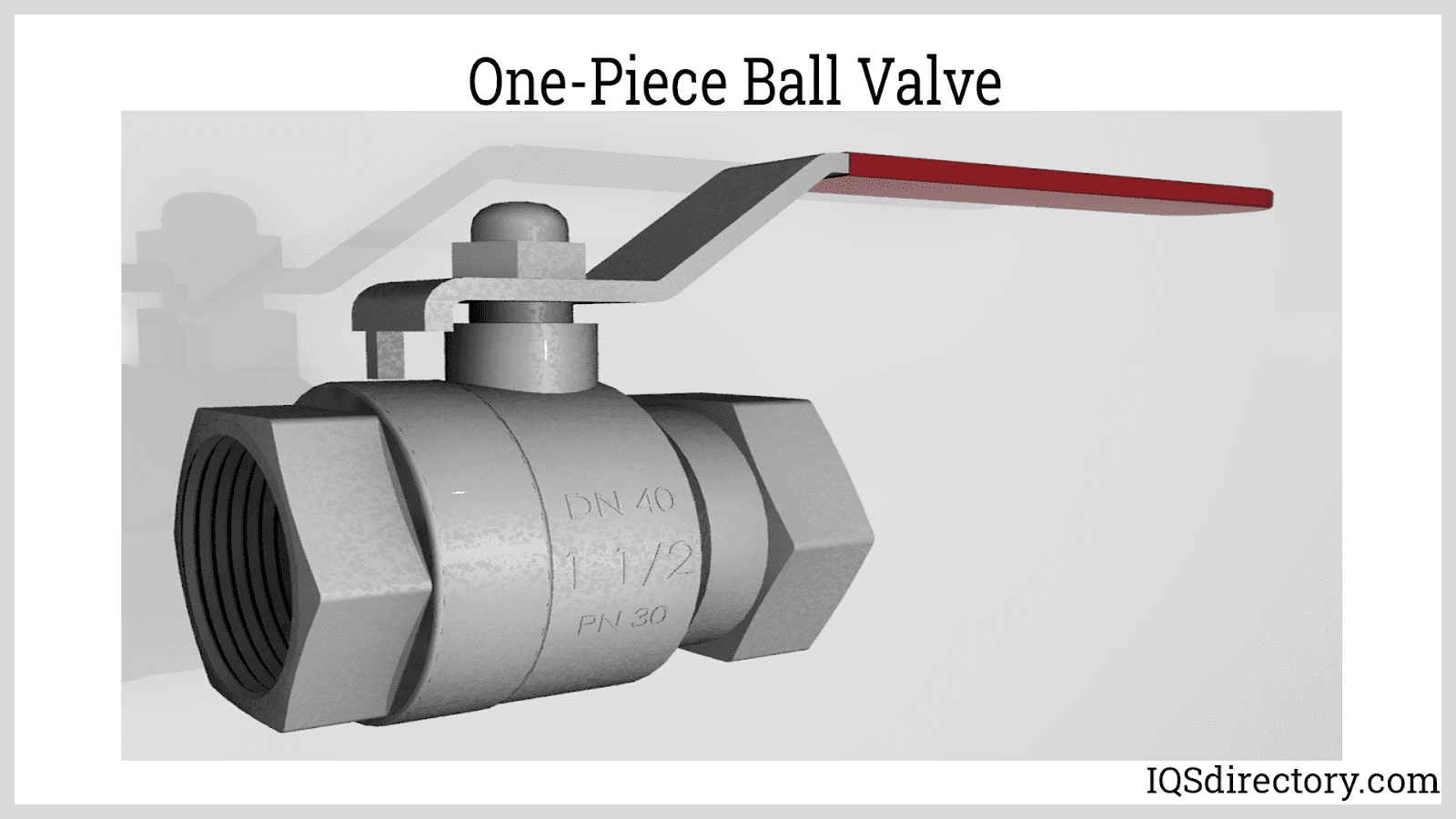
A ball valve is a shut-off valve that allows or obstructs the flow of liquids and gasses in a piping system by rotating the ball having a bore inside the valve for 90°. The ball is mounted against two seats and has a stem that connects it to the operating and control mechanism that rotates the ball...
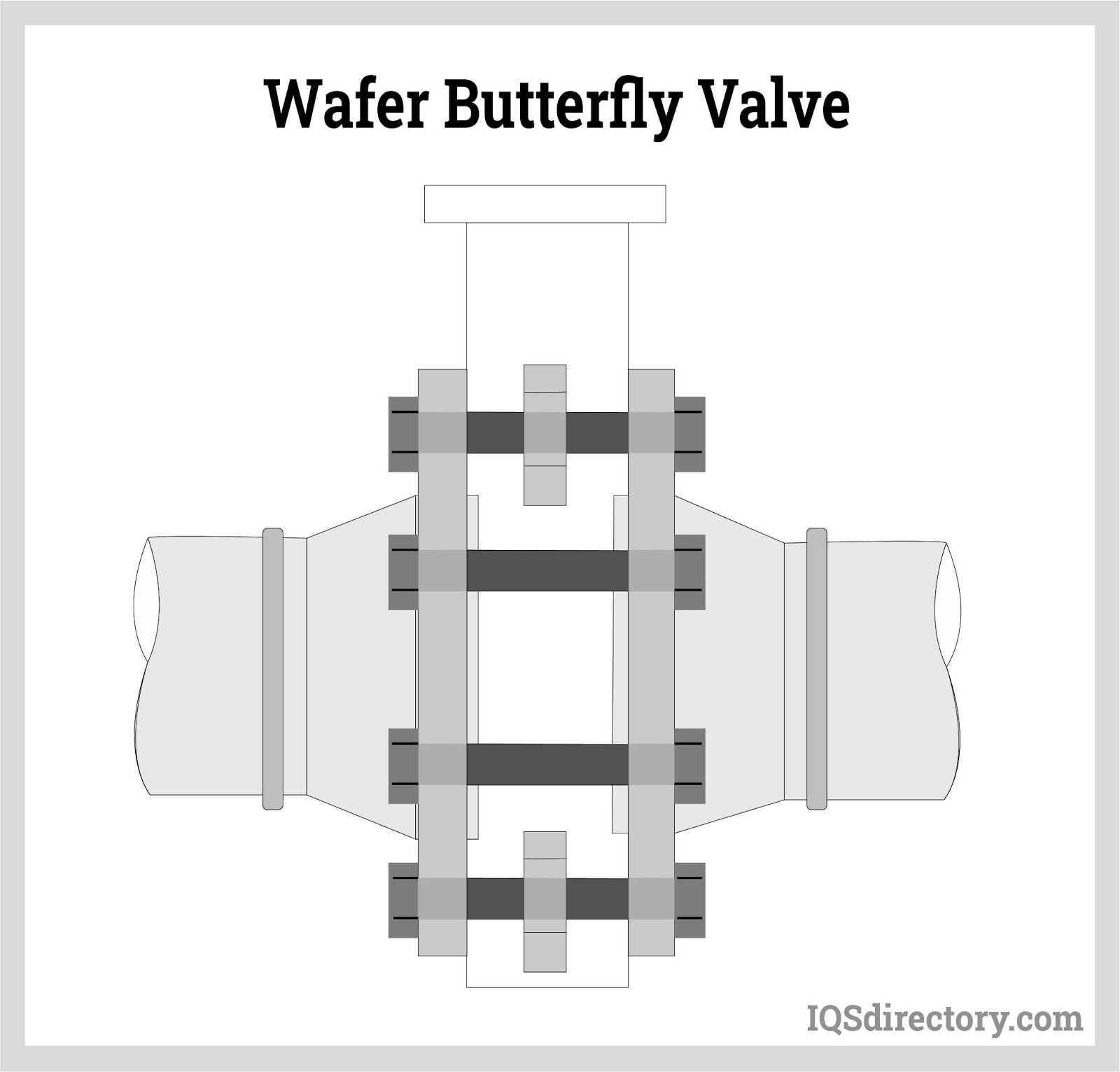
A butterfly valve is a quarter-turn rotational motion device that utilizes a rotary disc to allow, obstruct, or control the flow of fluids in a piping system. It features a rotating disc that is situated on the passageway of the flowing media...
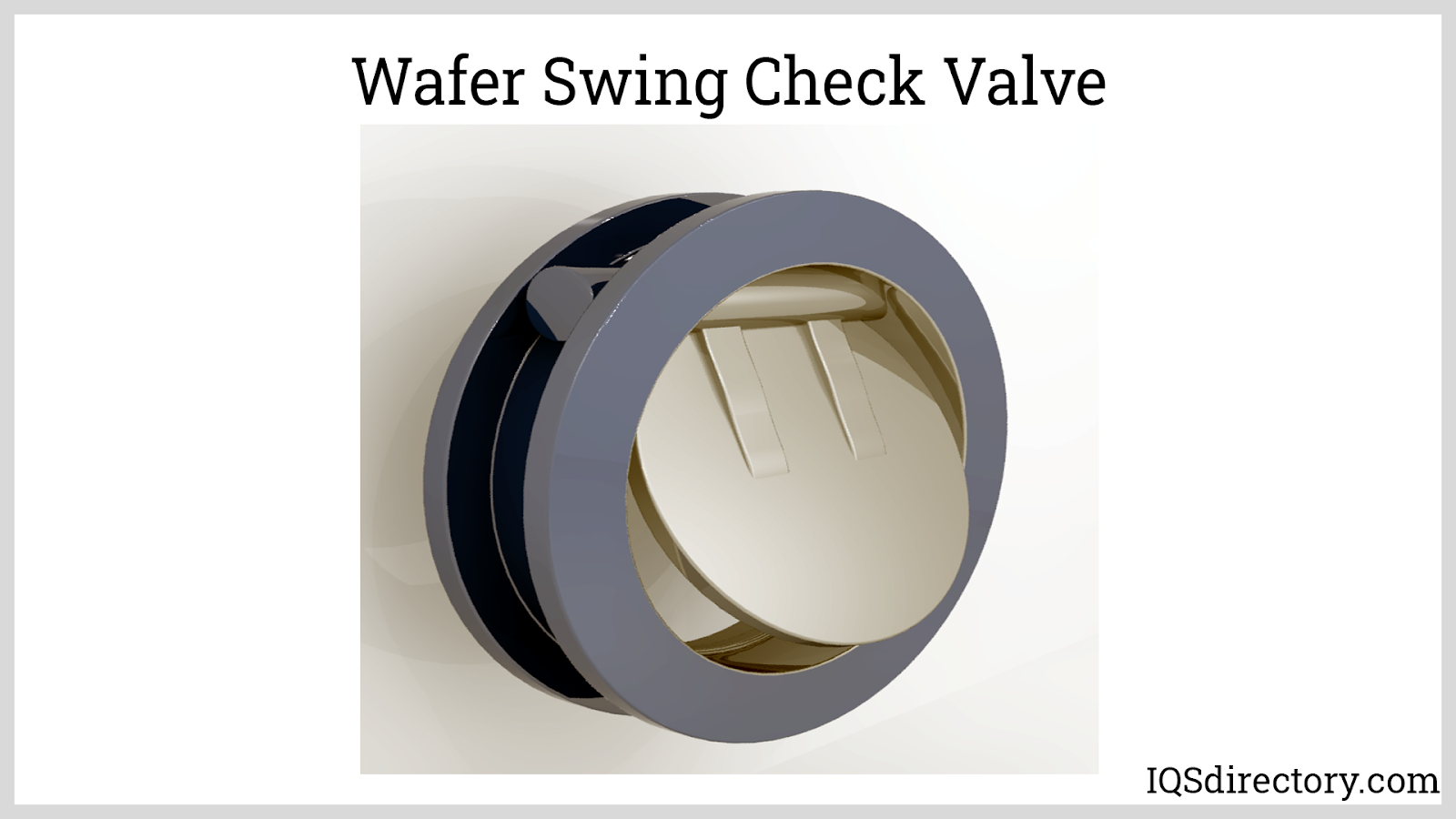
A check valve is a safety device designed to allow fluids and gasses to flow in one direction. Under pressure, fluids enter the valve at the inlet and exit through the outlet. Uninterrupted flow continues until the pressure drops, or the pump is shut down...
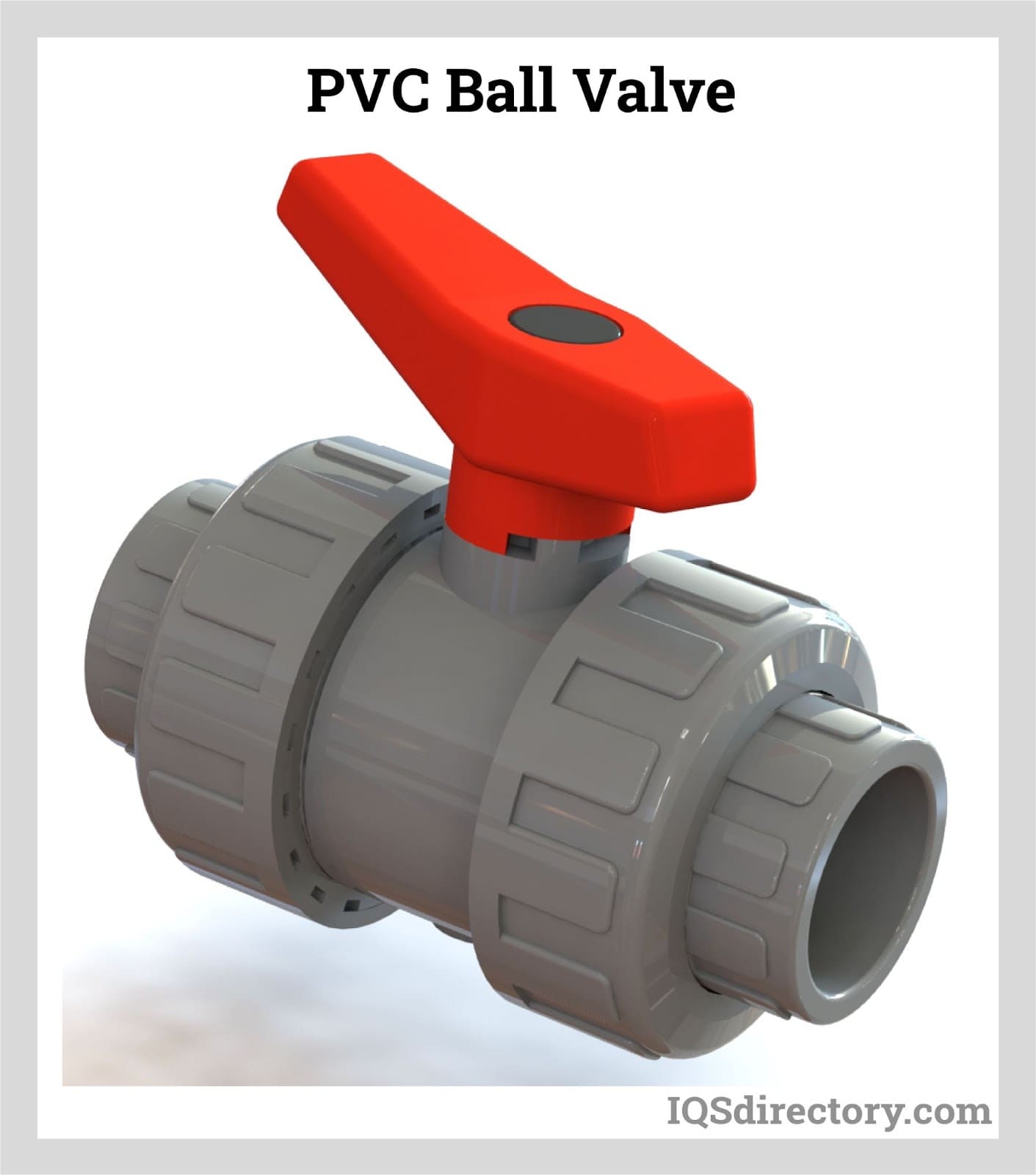
A PVC or polyvinyl chloride ball valve is a plastic on and off valve that has a rotary ball with a bore where turning the ball a quarter turn can stop the flow of a fluid. They are highly durable, cost effective and can be...
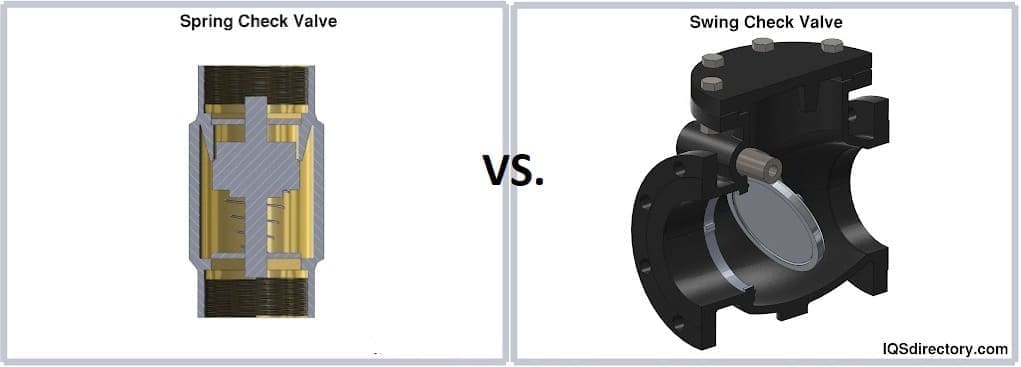
A spring check valve is a valve that ensures unidirectional flow and prevents reverse flow. They have a single inlet and outlet and must be placed in proper orientation to function correctly. On the side of a spring check valve, and all...